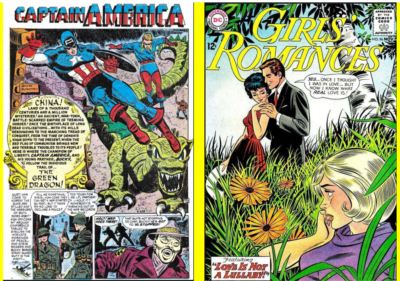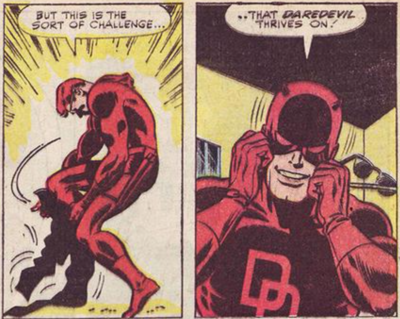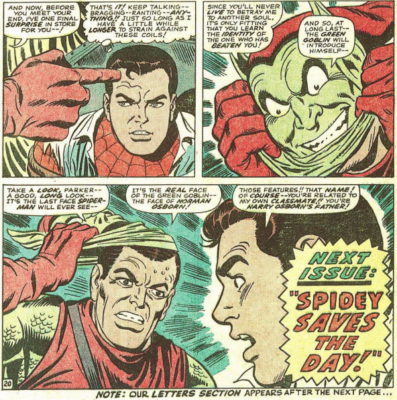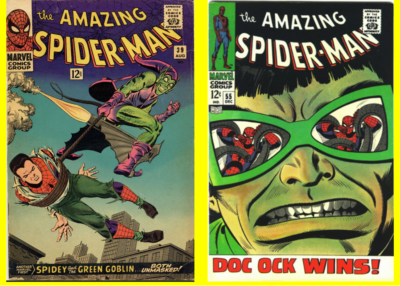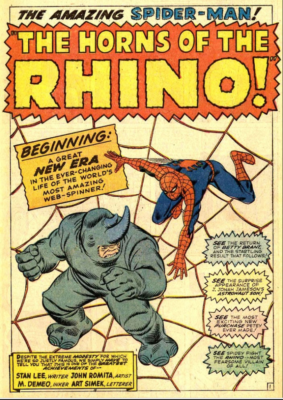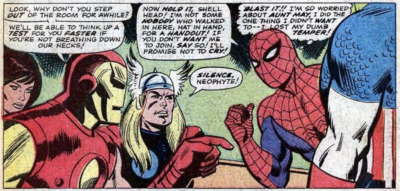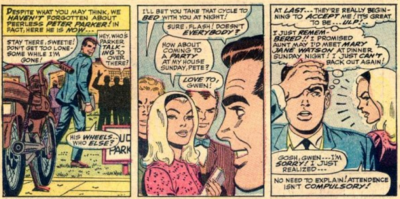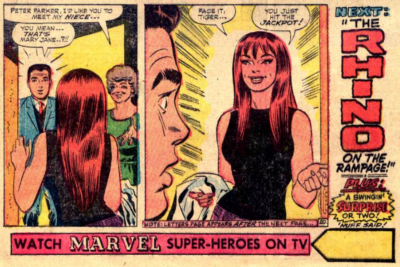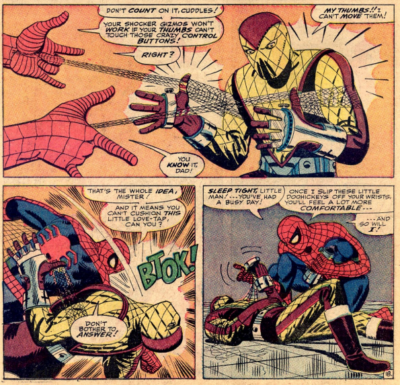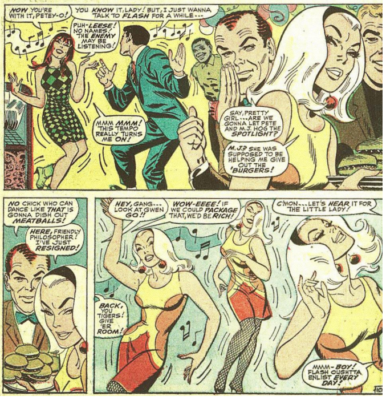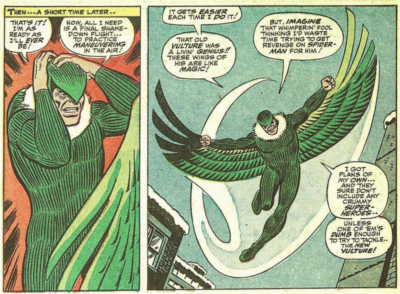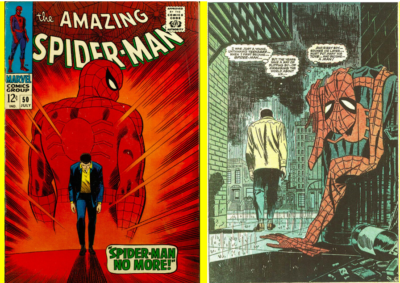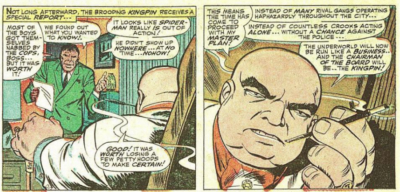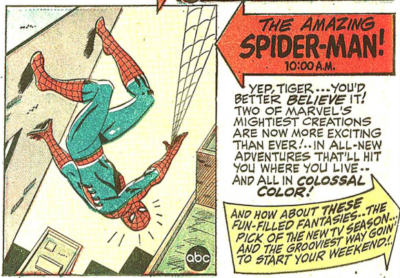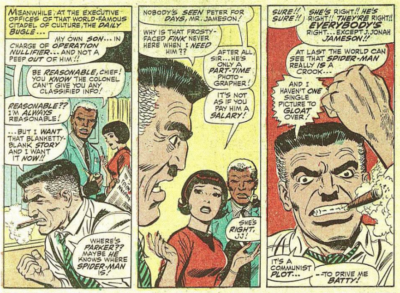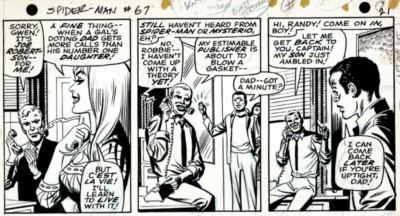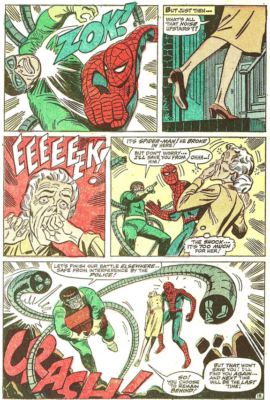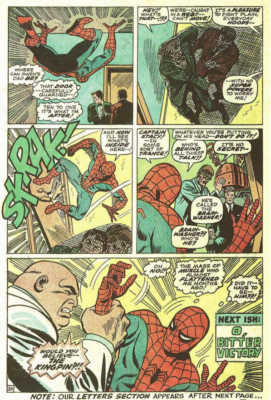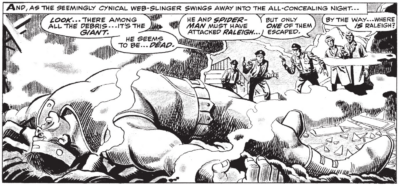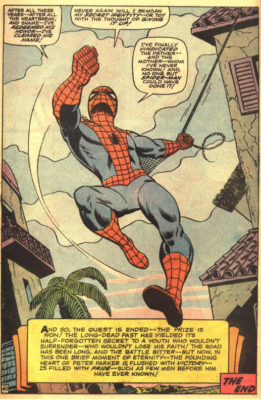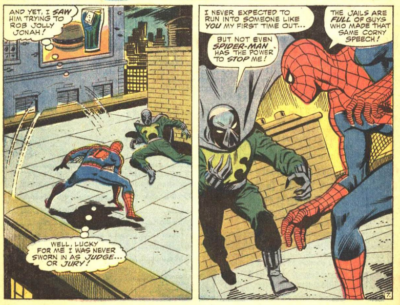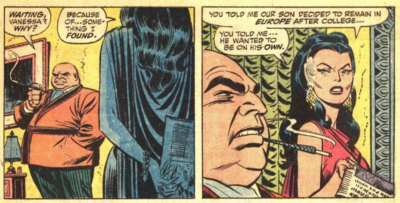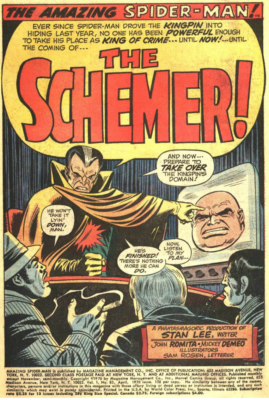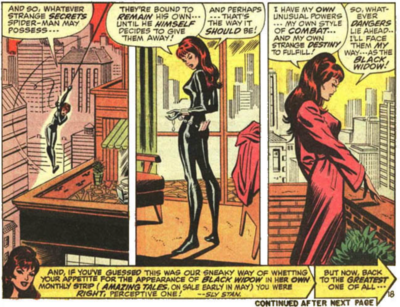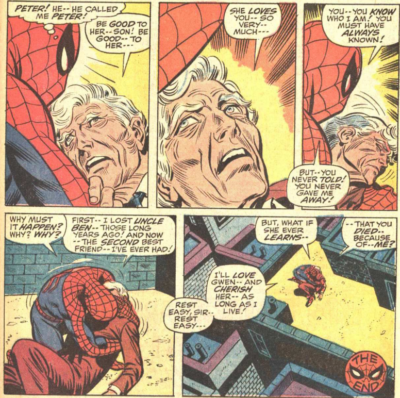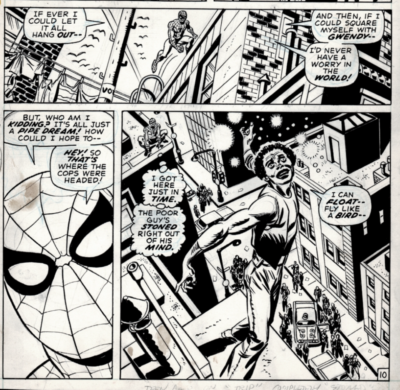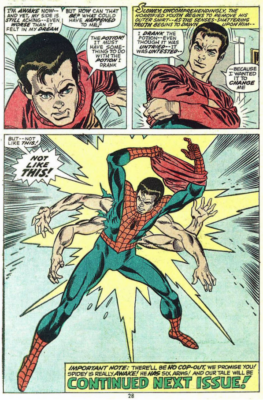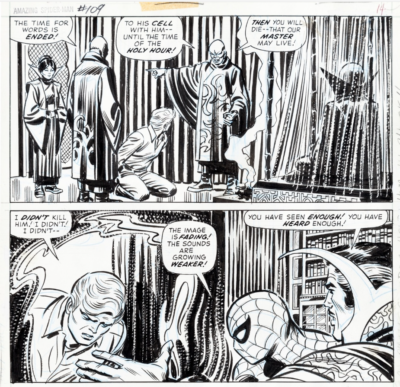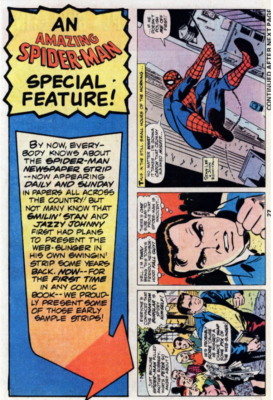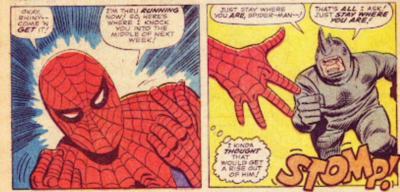‘The Romita Version’ – Exploring John Romita’s Recollections of Spider-Man: 1966 – 1971 by Rosco M
Introduction
John Romita (1930 – 2023) – also known as ‘John Romita Sr.’ – was a comic book artist best known for his iconic run with writer/edtior Stan Lee on the ‘Amazing Spider-Man’ title. He was the immediate artistic successor to Spider-Man co-creator Steve Ditko, who left the strip in late 1965.
Working within the context of the ‘Marvel Method’, Romita’s role as artist included co-plotting responsibilities as well as character design/development. Basic storylines were developed, to varying degrees, during conferences with Lee. Romita would then translate these ideas to the pencilled page, adding whatever elements were necessary to complete the visual narrative. Lee came to rely on Romita’s creative input to such an extent that he continued to involve him in the storytelling even when other pencillers (such as Gil Kane or John Buscema) were utilised.
Romita found great success with Marvel and Spider-Man, and he continued to be associated with both for the majority of his life. He also frequently interacted with the comifc book community, sharing his experiences in numerous interviews, articles and public appearances. Through Romita’s recollections it is possible to see how Marvel successfully sustained, and even increased, the popularity of Spider-Man following the key loss of Ditko.
This document summarises the ‘Romita-centric’ story of the creation of the ‘Amazing Spider-Man’ strip during the years 1966 to 1971, utilising selected quotes from a variety of sources, presented in a chronological narrative. Cover dates of relevant publications have generally been employed when referencing which work falls into which era, even though these do not reflect the actual date of sale (or, obviously, of production). This is done for the sake of simplicity and in recognition of the challenges in determining precisely when some of the events referenced by Romita took place.
Anyone with additional relevant information (i.e.: direct quotes from either Romita or a reliable secondary source) may provide this via the Comics Historian Website (Contact – Comic Book Historians). I also welcome any other constructive feedback in relation to factual errors, typos etc.
Rosco M
19 November 2023
Part One: 1965 – 1966
‘I didn’t know about the Fantastic Four, Spider-Man…’
John Romita first worked with writer/editor Stan Lee as a freelance comic book artist in 1951, illustrating one of Lee’s scripts for Atlas Comics (a precursor of Marvel). He subsequently drew a brief revival of the ‘Captain America’ strip for that company, utilising a bold style very reminiscent of cartoonist Milton Caniff, an artist he had greatly admired since childhood. By the end of the decade Romita had moved on and was doing regular assignments for competitor National/DC Comics – primarily on romance titles.
In mid-1965 Romita was considering leaving the comics industry altogether, having received an offer to work in advertising. Prior to making his decision he completed a freelance assignment for Marvel Comics, inking the interiors and cover for Avengers #23 (December 1966). It was at this point that Stan Lee made the offer of ongoing employment at Marvel Comics:
“(Lee) said, “I’ll guarantee you $250 a week, even if I don’t have a script for you.”
I didn’t have to learn new ropes, so I took the easy way out. I stayed in comics, and that’s how I stayed with Stan.”
— John Romita, John Romita Sr: Spidey’s Man Yakkin’ with Marvel’s (de facto) ‘70s Art Director, Comic Book Artist # 6, Interview by Jon B. Cooke, Fall 1999
Marvel had already established itself as a significant success on the newsstands, and Lee was working with freelance artists/creators such as Jack Kirby and Steve Ditko on a range of Marvel titles. Romita, while at National/DC, had even attended a meeting in which Marvel was being discussed:
“While I was working for DC they used to have discussions at the Bullpen…the editors…and I was at one of those discussions…and they were analysing what the hell was happening. Why is Stan Lee getting such a market all of a sudden? They had Stan Lee’s covers tacked up on a board and some of DC’s covers…saying “Ours are obviously better. Why are Stan Lee’s books getting noticed? Why are people buying them?”
— John Romita, The John Romita Sr. 2001 Shoot Interview by David Armstrong – YouTube
However, while Romita was aware that the company had become a serious competitor for National/DC, he knew little of the titles being published:
“I was really dumb. I never noticed what was happening elsewhere. I didn’t know about the Fantastic Four, Spider-Man, none of that stuff. By the time 1965 came and I was finished up at DC and went over to see Stan, I had no idea about the Spider-Man, or Iron Man, or Fantastic Four, or Avengers – I didn’t know any of those. So, Stan showed me all the stuff and gave me a quick rundown of what was happening. And he said, “you have no idea of how popular these guys are”. He showed me ‘Amazing Spider-Man’ and said “Would you believe this is our second most popular comic book?” And I thought it was terrible. I didn’t think it was anything to look at. But Stan said that the readers were starting to care about these characters.”
— John Romita Comics Interview Super Special Spider-Man Spectacular, 1990, interview by Jim Salicrup
“My first impression of Spider-Man was that this was a teen-aged Clark Kent with glasses. I said to Stan, “This is your number two selling book? I can’t believe it.” I had never seen Spider-Man before 1965. July of ’65 was the first time I had even heard about it.”
— John Romita, John Romita Sr: Spidey’s Man Yakkin’ with Marvel’s (de facto) ‘70s Art Director, Comic Book Artist # 6, Interview by Jon B. Cooke, Fall 1999
Unlike many of his artistic contemporaries at Marvel, Romita expressed a preference for working at the office rather than from home:
“I told (Lee) I needed to come into the office; it’s the only way I’m going to produce. Then I said, “If I pull an all-nighter to get a job in, I may not come in the next day.” He said, “Do it any way you want.” I really had it made. I was in there using their materials and drawing table; it really saved my life. I stayed there for 30 years.”
— John Romita, John Romita Sr: Spidey’s Man Yakkin’ with Marvel’s (de facto) ‘70s Art Director, Comic Book Artist # 6, Interview by Jon B. Cooke, Fall 1999
Romita was initially hoping to concentrate on inking at his new company, having felt ‘burned out’ after years of pencilling. Regardless, his first ongoing assignment would be as a pencil artist for the ‘Daredevil’ title, commencing with issue #12 (January 1966). This was a strip that had been revitalised some months earlier by veteran artist Wally Wood, who departed after a short but distinguished run. Lee had originally considered Dick Ayers as a replacement for Wood, however he wasn’t satisfied with some preliminary artwork and asked Romita for his take:
“…he asked me if I could do a one-page rough version of how I would draw a Daredevil page that Dick had done. It was one that had Ka-Zar and Zabu. I did a quick sketch, and Stan went crazy. He loved it. He said, “You’ve got to pencil this for me!” I told him I’d rather ink, asked if he could get someone else to pencil it; he said there wasn’t anyone else.”
— John Romita, Comics Interview Super Special: Spider-Man 1990 (interviewed by Jim Salicrup)
‘He told me he didn’t do his stories full script…’
It was at this point that Romita discovered the days of working full-script were largely gone at Marvel. Lee had taken on a major portion of the company’s editing/scripting responsibilities, and his preference was for completing the dialogue/narrative after the artwork had been pencilled. The actual process of plotting/storytelling was, to varying degrees, a role shared with the artist. A brief explanation of the (then un-named) ‘Marvel Method’ appeared in the ‘Bullpen Bulletin’ page of publications dated February 1966:
“It isn’t generally known, but many of our merry Marvel artists are also talented story men in their own right! For example, all Stan has to do with the pros like JACK ‘KING’ KIRBY, dazzling DON HECK, and darlin’ DICK AYERS is give them the germ of an idea, and they make up all the details as they go along, drawing and plotting out the story. Then, our leader simply takes the finished drawings and adds all the dialogue and captions! Sounds complicated? Maybe it is, but it’s another reason why no one else can bring you that old Marvel magic!”
This approach initially came as a shock to Romita, as he would recall in numerous interviews, e.g.:
“… (Stan Lee) told me he did not do his stories full-script. And I went crazy.” I told him I could never do it.”
— John Romita, Comics Interview Super Special: Spider-Man 1990 (interviewed by Jim Salicrup)
“It was terrifying. At first I told him I couldn’t do it. I told him I wouldn’t know what to draw.”
— John Romita, ‘The Amazing John Romita’, Comics Spotlight #1, Summer 2002, Interview by Jeff Hams
Despite his initial reservations, Romita was soon preparing for the strip:
“… I read the nine or ten issues of Daredevil that Stan gave me to bone up on the character.”
— John Romita, Comics Creators on Spider-Man, by Tom DeFalco, Titan Books, 2004 interviewed by Tom DeFalco
When Romita experienced some initial difficulty in achieving the level of dynamism that Lee expected, he received assistance from legendary creator/artist Jack Kirby:
“I did three pages and took them into Stan and he wasn’t exactly overwhelmed. He loved the splash page because it was dynamic and a good intro, but he said pages two and three were a bit quiet. And, you know, I really had that feeling myself. He got Jack Kirby to do what we call pacing breakdown, that was ‘Daredevil’ #12. In other words, Jack would draw circles and balloons on the page, and indicate where tight shots would go, long shots, that sort of thing.”
“And after the first issue I didn’t think I could do the second one – I don’t know where the strength came from. Sort of like throwing a child into a pool and telling him to swim.”
“Jack did issue #13 with me as well. After that issue I had it all figured out and I was ready to take it on by myself.”
— John Romita, ‘The Amazing John Romita’, Comics Spotlight #1, Summer 2002, Interview by Jeff Hams
Lee worked particularly closely with Romita in the early days to ensure that he knew exactly what was expected of him:
“And then there was a period where, every time I would hand a story in, Stan would go through this long session in which he would explain the way he wanted things done. It was a long process – time consuming, but also very gratifying; I hadn’t had that kind of enthusiasm for artwork for years. That romance stuff (at DC) had just stifled me. I always gave it my best shot, but I had lost my enthusiasm. Suddenly, I was getting enthusiastic, and even though it was hard work, I felt alive again.”
— John Romita, ‘The Foom Interview’, FOOM # 18, June 1977, interview by David Anthony Kraft
Romita would never be completely comfortable with plotting/co-plotting responsibilities, though he subsequently came to appreciate the strengths of Lee’s approach:
“It actually turned out to be a godsend. In retrospect, full script narrowed your scope because you were limited by the parameters of the writer. Stan’ style opened up all sorts of possibilities. Of course, it is much harder to do it that way, and when you’re looking to make a living at it you don’t necessarily look for the hardest way to do things.”
— John Romita, ‘The Amazing John Romita’, Comics Spotlight #1, Summer 2002, Interview by Jeff Hams
Romita found that he often needed to take his work home and work additional hours to complete it. Then, after bringing in the final pages for a story, it would be time for another plotting session with Lee:
“We would get together and talk for about an hour. Generally it was after I had stayed up all night to finish a job. I would bring the story in, and then without me getting any sleep, he would start giving me the next story. If Stan weren’t such a histrionic character, I probably would have fallen asleep right there, but he kept me awake because he was really jumping all over the office. He was using different voices, shouting, screaming, running down the hall – he really did all those crazy things.”
“I’d try to take notes and ask him to explain things that I was unclear about, but he never wrote anything down. The Daredevil stories I did were all verbal; in fact so was Amazing Spider-Man.”
— John Romita, Comics Interview Super Special, interview by Jim Salicrup
Romita would break the plot outline developed in these meetings into a panel continuity, adding any story elements required to complete the visual narrative. Margin notes were included to explain what was being presented/intended. Lee would then review/edit the pages, request any required changes, and provide the dialogue/script and narration.
‘Stan told me that he was having disagreements with Steve Ditko’
It was during their plotting sessions that Romita learned of the creative difficulties taking place on the ‘Amazing Spider-Man’ title, which Lee was still producing with Steve Ditko:
“Stan and I were plotting Daredevil verbally, and we would often get into conversations about the other people he was working with. Stan told me that he was having disagreements with Steve Ditko over almost every Spider-Man plot. Ditko was plotting the stories by himself and Stan was very unhappy with the results. Ditko had a different take on storytelling than Stan.”
“Steve would just drop off the pages with Sol Brodsky and never talk to Stan about them”
— John Romita, Comics Creators on Spider-Man, by Tom DeFalco, Titan Books, 2004 interviewed by Tom DeFalco
In contrast, the Lee/Romita team was working smoothly. And, despite the challenge of following in the footsteps of Wally Wood, Romita’s style found favour with the ‘Daredevil’ audience:
“…Daredevil began to look pretty good. It started to improve in sales, which was a good sign. With that, Stan asked me to take home a stack of Spider-Man books, all the existing issues up to that time (around #33 or #35), and to get used to the character, in case I ever had to back it up. I spent the weekend looking them over. And then, about two or three months later, he said Steve was leaving Marvel.”
— John Romita, ‘The Foom Interview’, FOOM # 18, June 1977, interview by David Anthony Kraft
Part of Lee’s ‘back-up’ plan apparently involved having Spider-Man guest-star in a two-part Daredevil tale beginning with issue # 16. The story would also feature appearances from Spider-Man’s supporting cast. When asked many years later whether he suspected this was Lee’s way of trying him out as a potential for replacement for Ditko on ‘Amazing Spider-Man’, Romita replied:
“Actually, I did think so – but I was hoping against it, believe it or not. People laugh when I say this, but I did not want to do Spider-Man. I wanted to stay on Daredevil.”
—John Romita, ‘John Romita: Fifty Years on the ‘A’ List’, John Romita…And All that Jazz!, TwoMorrows, 2007 page 48 interviewed by Roy Thomas
In a separate recollection Romita was more direct:
“Stan contrived that because he and Steve Ditko were not getting along.”
“Since Stan knew that Ditko was about to take off, he decided to see if I could draw Spider-Man. That’s why he guest-starred the web-head in my book.”
— John Romita, Comics Creators on Spider-Man, by Tom DeFalco, Titan Books, 2004 interviewed by Tom DeFalco
Ditko quit Marvel in late November 1965, completing the final pages for Amazing Spider-Man # 38, an issue that would appear on the stands in April 1966 with a cover date of July 1966. Romita was, as anticipated, the obvious replacement:
“I did about six issues of it (Daredevil) when Stan sprang Spider-Man on me, and truth be told, I was hoping not to do Spider-Man. I tried out two issues in Daredevil with Spider-Man in it as a start. I never dreamed Ditko would say away from the book; I thought Ditko would leave for a couple of months and then come back. I was rooting for it because I didn’t want to give up Daredevil. I was starting to enjoy it so much, and to this day he’s still my favorite character.”
— John Romita ‘The Versatile Virtuoso’. Comic Book Marketplace Special Edition 5, Summer 2002 Interview by Arnold T. Blumberg
In spite of his feelings on the matter, Romita felt a sense of duty to move to where he was required the most:
“The only reason I did Spider-Man was because Stan asked me and I felt I should help out, like a good soldier.”
Even if he did believe he was a better fit on his current strip:
“…when I did the Spider-Man/Daredevil stories, I really felt it was obvious I couldn’t do Spider-Man as well as I could do Daredevil.“
—John Romita, ‘John Romita: Fifty Years on the ‘A’ List’, John Romita…And All that Jazz!, TwoMorrows, 2007 page 48 interviewed by Roy Thomas
Another quote from Romita highlights the empathy he felt for Lee, who was faced with the monumental task of sustaining the Spider-Man character after the loss of Steve Ditko:
“I was amazed when Stan gave me Spider-Man to do. I felt he was desperate. So I did the book to help him out, hoping all the while that it would only be temporary.”
—John Romita, ‘John Romita: Fifty Years on the ‘A’ List’, John Romita…And All that Jazz!, TwoMorrows, 2007 page 48 interviewed by Roy Thomas
Romita’s final issue of Daredevil was #19 (August 1966), at which point the artistic responsibilities on that title were passed to Gene Colan (with Lee continuing on as writer/editor).
‘Ditko had established the style for Spider-Man’
Romita began his new assignment on ‘Amazing Spider-Man’ with mixed feelings about his predecessor’s approach:
“…I felt the series was drawn too crudely. I was getting slicker in my style when I was doing Daredevil, but I felt obliged, when I took over Spider-Man, to keep the Ditko feel.”
“Although I felt the art was crude, I did start to admire it around issue #29 or #30. Steve Ditko started getting real sharp – I loved the sequence with the machinery in #31, #32, #33. I felt that was a sensational series. I think if Steve hadn’t had philosophical clashes with Stan, he would have done excellent stuff.”
— John Romita Comics Interview Super Special Spider-Man Spectacular, 1990, interview by Jim Salicrup
“Ditko had established the style for Spider-Man and there were a lot of panels with a lot of characters and a lot of talking heads. When I did westerns I did a lot of large panels. It was hard to do Spider-Man in the Ditko style…”
— John Romita, ‘The Amazing John Romita’, Comics Spotlight #1, Summer 2002, Interview by Jeff Hams
Regardless, Romita felt an obligation to carry on that style to maintain some continuity, particularly given the possibility that Ditko would return:
“I said to myself, “Naw, he’s not going to stay away. I didn’t know Ditko. I assumed he’d do what I would have done – he’d think about how he had given up a top character, and he’d be back. And I was sort of counting the days until I could get back on Daredevil.”
—John Romita, ‘John Romita: Fifty Years on the ‘A’ List’, John Romita…And All that Jazz!, TwoMorrows, 2007 page 48 interviewed by Roy Thomas
‘Plotting usually consisted of the two of us throwing ideas at each other… ‘’
The Lee/Romita team developed storylines for the Spider-Man strip in the same manner that they had on ‘Daredevil’, utilising story/plotting conferences. Each individual assessed the merits of particular suggestions from their own perspective:
“The plotting usually consisted of the two of us throwing ideas at each other until one of them seemed “visual” enough for me and provided Stan with opportunities to advance the story.”
— John Romita, “More Than His Share of Trouble”, 2006 Intro Amazing Spider-Man Omnibus Vol 3. 2017
A greater amount of time was generally devoted to the plotting conferences in the earlier part of the Lee/Romita ‘Amazing Spider-Man’ run than later on. Lee’s input was particularly evident with respect to the choice of villain and the life developments:
“First it was two or three hours, then it was an hour. Stan would tell me who he would like to be the villain, and personal life “threads” he would like carried on. Generally we would select the setting; sometimes we wouldn’t even have time to select the settings, like “it takes place on a subway.” He would give me that, and tell me where he wanted it to end. I would fill in all the blanks.”
— John Romita, John Romita Sr: Spidey’s Man Yakkin’ with Marvel’s (de facto) ‘70s Art Director, Comic Book Artist # 6, Interview by Jon B. Cooke, Fall 1999
Lee brought in Roy Thomas (recruited by Lee as a writer for Marvel in late 1965) to take minutes during one early plotting session, during which Lee/Romita made longer term plans for their run:
“…(Lee) moved John Romita over from drawing Daredevil to drawing Spider-Man, and within a few days the two of them were spiritedly plotting away—not just the next issue or two, but the general flow of events for several months to come, with me called into Stan’s office to observe and take notes, for the benefit of both gents.”
Roy Thomas, ‘Steve D., We Hardly Knew Ye!’ Alter Ego 160, 2023
In another account Thomas recalled the planning as extending ‘six months’ into the future, rather than three:
“And they were sitting there talking and starting ideas and where it would be in six months, and this and that. Just, in a general way, spit-balling everything.”
In normal circumstances any documentation during these sessions was left to Romita. He initially took notes, as he had with Daredevil:
“When we first started, we would have a long verbal session. Stan would start acting out the story, and I would try to take notes. But then, whenever I would start to write down a scene, Stan would decide to throw it out and come up with another version. After a while I stopped taking notes altogether, and just tried to remember everything Stan said. I would leave his office with my head buzzing. Not only did I have to remember which scenes he wanted, but which variation of a particular scene.
— John Romita, Comics Creators on Spider-Man, by Tom DeFalco, Titan Books, 2004 interviewed by Tom DeFalco
Confusion arising from the lack of clarity could be further could be exacerbated by the differing memories of the conference participants:
“Many times, I thought I had convinced Stan that we were going to go in a certain direction in a storyline. And then when he would get the work, he would say “No, that’s not what we agreed on.” And I’d say, “Yeah, don’t you remember? You said ‘go ahead with that.’ So everybody has his own memory. I went home and tried to remember what we were talking about, but I had trouble separating what I remembered that Stan said, and what I wanted to do. I should have taken notes, but couldn’t because I was so busy trying to juggle ideas with him. We would always throw ideas up in the air and try to figure out some way around them.
“If I had kept more notes, I’d have gone crazy, but I should have recorded our conversations. I’d have remembered what he suggested and which ones sounded more convincing to me, and which ones were more important to him than others.”
—John Romita, ‘John Romita: The 2006-2007 Interview’, John Romita…And All that Jazz! TwoMorrows, 2007 interview by Jim Amash
The nature of Romita’s commentaries makes it impossible to determine when the earlier, lengthier plotting sessions ceased to be the norm. What is clear is that the process became more haphazard as time went on, primarily due to the competing demands of the work environment. Regardless of how much detail was worked out with Lee on any particular occasion, it was ultimately Romita’s responsibility to produce the pencilled pages for each month’s instalment. As such, his conceptual/creative contributions to the Spider-Man mythos would be significant.
The Goblin Revealed
Lee commenced the team’s ‘Amazing Spider-Man run with a major, two-part storyline, commencing in issue #39 (August 1966), which resolved the long-running mystery behind the villainous Green Goblin. Spider-Man’s foe was revealed as Norman Osborne, and his immediate threat was ended via the plot device of selective amnesia.
Romita recognised the significance, but was unsure of Lee’s precise motivations for beginning their run with this event:
“I never could get a straight story from Stan. I don’t know if he had me do that particular story because he was worried that sales would fall off without Ditko and he wanted a big event, or because he wanted me to cut the cord with Ditko.”
— John Romita, Comics Creators on Spider-Man, by Tom DeFalco, Titan Books, 2004 interviewed by Tom DeFalco
Romita would recall hearing from Lee (rightly or wrongly – see ‘End Notes’) that the Goblin’s identity had been a cause of tension in the Lee/Ditko relationship, e.g.:
“Stan mentioned that they were having disagreements on the identity of the Green Goblin. Ditko wanted the Green Goblin to be just a guy that nobody knew. He felt that you shouldn’t always be able to recognise a super-villain when you unmask him. Ditko thought it was more dramatic if it turned out to be somebody you didn’t know. Stan, though, felt they had set up a mystery about the Green Goblin’s real identity and it would be a cheat if he turned out to be some Joe Blow. Stan and Steve disagreed violently on that, and Steve eventually left.”
— John Romita, Comics Creators on Spider-Man, by Tom DeFalco, Titan Books, 2004 interviewed by Tom DeFalco
Cover Designs
The distinctive cover of Amazing Spider-Man #39, with the unmasked Spider-Man being carried by the Goblin over the rooftops, reflected Romita’s knack for compelling cover compositions. During the creation of such covers, Lee would provide occasional input and critique Romita’s preliminary sketches:
“Sometimes we got together, other times he would just tell me to come up with a couple of sketches.”
“For instance, if I did a fight scene and he wanted a scene with somebody showing some kind of personal emotion, he would tell me, “I want a personal character shot with an expression.” Most of the time Stan was happy with my ideas. He might make minor changes, ask for a bigger figure or show the front view of Spider-Man instead of the back view; that kind of stuff. But he was very, very open to my ideas, and I seldom had trouble with him on cover sketches. He liked my ideas quite a bit.”
— John Romita, ‘John Romita: The 2006-2007 Interview’, John Romita…And All that Jazz! TwoMorrows, 2007 interview by Jim Amash
“The ones I enjoyed were the trick covers – you know, the big close-up of Doc Ock with reflections in his eyeglasses, Spider-Man’s costume pinned to the wall. Stan made the covers very important. His attitude was that if the comic didn’t have a good cover, nobody is going to notice it.”
— John Romita, Comics Interview Super Special Spider-Man Spectacular, 1990, interview by Jim Salicrup
‘He didn’t want to use a lot of Ditko’s villains’
Despite Lee’s initial use of the Green Goblin, he had no intention of reyling purely on recycled opponents for the strip:
“…he didn’t want to use a lot of Ditko’s villains. He felt they had overused them already, so we always tried to come up with new ones. I started sharpening my creative skills that way.”
An Interview with John Romita by Tom Spurgeon – The Comics Journal (tcj.com)
The creation of these new villains could begin simply with the name:
“Stan would come in and sometimes just pin a piece of paper with a name on it on my drawing board when was out.”
“When Stan did this, I’d do up some sketches and bring them in and ask him what he thought.”
— John Romita, Comics Interview Super Special Spider-Man Spectacular, 1990, interview by Jim Salicrup
“The first one I think was the Rhino. Stan would just write the words, “Next month: The Rhino.” And I would have to come up with a character that looked like a rhino or based on a rhino.”
An Interview with John Romita by Tom Spurgeon – The Comics Journal (tcj.com)
Romita confessed to a lack of confidence in his initial Rhino design, but received support from fellow artist Marie Severin:
“I didn’t think the Rhino was going to work until Marie Severin did a drawing of the Rhino in action. I did a drawing of the Rhino and I was about to reject it, when Marie Severin said, “I like that.” I said, “It looks silly, the face sticking out below the horn.” And she showed him charging like a bull, and I said, “You know, you’re right.”
An Interview with John Romita by Tom Spurgeon – The Comics Journal (tcj.com)
“I was always late on deadlines…’
Although he would occasionally produce the full art (pencil/inks) in the first years of the strip, Romita’s pencils on his early Spider-Man stories were provided by Mike Esposito, working under the pseudonym of Mickey Demeo. This was partly due to Romita’s working speed:
“I was always late on deadlines. If I was the kind of guy that had the luxury of being able to pick up speed any time I wanted and finish up something, I would have done it. But I was always so late that I didn’t have the luxury of taking time off. I was afraid to. Even if I was on time, I was afraid to.”
— John Romita, ‘John Romita: The 2006-2007 Interview’, John Romita…And All that Jazz! TwoMorrows, 2007 interview by Jim Amash
Romita’s ability to draw the Spider-Man strip in the office was also compromised by the same environmental factors that impinged on the plotting sessions:
“That was a stupid idea I had of working in the office. Stan started taking advantage of it almost immediately; cover sketches, corrections, and occasionally toy designs, and I was supposed to be doing Spider-Man. He immediately started to stretch me the wrong way, and I let him do it.
— John Romita, John Romita Sr: Spidey’s Man Yakkin’ with Marvel’s (de facto) ‘70s Art Director, Comic Book Artist # 6, Interview by Jon B. Cooke, Fall 1999
“…I’d be fighting a Spider-Man deadline and Stan would tell me “Okay, don’t do any cover sketches today. Just get Spider-Man done. Close your door.” So I would close my door, and Stan would put a sign on the door ‘Don’t disturb John Romita.’ And guess who was the first guy through the door to bother me! He would say , “John, I’ll only bother you for a minute. I’ve got one little thing I want to do.” But he was so explosive, and so full of enthusiasm, that it was hard to resist him.”
— John Romita, ‘John Romita: The 2006-2007 Interview’, John Romita…And All that Jazz! TwoMorrows, 2007 interview by Jim Amash
Adding to the pressure was the fact that Romita’s arrival on Spider-Man coincided with the task of producing the third Spider-Man annual, which would include a new 21-page story guest-starring the Avengers and the Hulk. As a result, Romita only provided the layouts, while pencils were by Don Heck and inks by Esposito. Even so, it was necessary for Romita to employ the uncredited assistance of artist Bill Ward for a portion of ‘Amazing Spider-Man’ #41 (October 1966).
‘A great new era in the ever-changing life of the world’s most amazing web-spinner!’
Continuing the momentum of their opening storyline, Lee emphasised to readers that further changes to the status quo were being made…while reminding them that the strip had never been a static one:
“Beginning – A great new era in the ever-changing life of the world’s most amazing web-spinner!”
— Stan Lee, Splash page narrative from Amazing Spider-Man #41, October 1966
Within that same issue’s storyline Lee/Romita had Peter Parker purchase a motorcycle – highlighting the character’s new independence (even though it would only make a handful of appearances before apparently being sold for cash by issue #66). Peter’s relationship with his college peers continued to position him as less of a social outsider, and more of an adult. The character of Betty Brant was brought back, only to be quickly paired off with someone else (Ned Leeds). The latter move effectively quarantined Betty from Peter Parker’s romantic life, perhaps in anticipation of one of Lee’s priorities – the full introduction of Mary Jane Watson as an active member of the cast.
As Romita recalled, Lee was also keen to take a different approach to the way in which Mary Jane was being portrayed by Ditko:
“…Stan had Mary Jane in the wings in Amazing Spider-Man for about six months. We’d see the back view of her, Anna Watson would mention her. And when I took over the art, Stan said “One of the good things about you taking over is that I can bring Mary Jane into the story.” And I asked Stan what he meant, and he told me that he didn’t like the way Ditko was doing Mary Jane. “
— John Romita, Comics Interview Super Special Spider-Man Spectacular, 1990, interview by Jim Salicrup
Surprisingly, Lee and Romita engaged in some discussion as to whether or not Mary Jane would be rendered as attractive. This was despite the fact that the answer had already been established (albeit briefly) during the Lee/Ditko run:
“Remember the shot where Ditko puts her behind foliage? And then Betty Brant and Liz looked at her waiting in some office and said “Oh, she’s a knock-out.” Stan forgot that. That was a few months before I took over. Then we started talking about issue #42, Stan said, “What do you think? Should we make her good-looking?” It’s a good thing we made her good-looking, because he’d already established that she was!”
— John Romita, ‘John Romita: The 2006-2007 Interview’, John Romita…And All that Jazz! TwoMorrows, 2007 interview by Jim Amash
Regardless of the initial confusion, Lee went on to develop a specific vision…one that was in accordance with the contemporary vibe that was rapidly becoming evident in the Lee/Romita era:
The go-go dancers were hot then. Stan wanted Mary Jane to be a wild, real flashy, stream-lined girl. Someone who was really today.”
— John Romita, Comics Interview Super Special Spider-Man Spectacular, 1990, interview by Jim Salicrup
As he would do on numerous occasions, Romita took specific inspiration for the new character’s design from the cinematic world:
“I used the actress Ann Margaret as a guide. I added dimples and a cleft in the chin so that she’d look that much more different from Peter’s girlfriend at the time, Gwen Stacy. When I did Gwen, I did her as icy and cold and aloof as Ditko did; and when Mary Jane came in I made her as fiery as we could. I did a colour sketch, suggesting the red hair. I don’t think her hair was red in the previous books. And I wanted her to have green eyes.”
— John Romita, Comics Interview Super Special Spider-Man Spectacular, 1990, interview by Jim Salicrup
Mary-Jane Watson’s first full appearance appeared in the final panel of ‘Amazing Spider-Man’ #42 (November 1966) – the first of a number of issues in which Romita provided his own inking.
‘I realised it wasn’t temporary…’
Mary Jane’s glamorous debut became a classic moment in American comic books. However, while clearly an outstanding beauty, the character wasn’t particularly out of place in the revamped Romita cast. Although still recognisable, everyone in the strip was now being rendered in a much more conventionally attractive manner than under Ditko. This was despite Romita’s attempts to maintain an early visual consistency with his artistic predecessor:
“On Spider-Man I felt obliged to ghost Ditko because – this may sound naïve, but I was convinced in my own mind, that he was going to come back in two or three issues.”
—John Romita, ‘John Romita: Fifty Years on the ‘A’ List’, John Romita…And All that Jazz!, TwoMorrows, 2007 page 48 interviewed by Roy Thomas
“…on Spider-Man I was doing these nine-panel pages and the thin line, and I was doing Peter Parker without any bone structure- just like Ditko was doing, I thought. The only reason it wasn’t better was that I couldn’t ape him any better.”
—John Romita, ‘John Romita: Fifty Years on the ‘A’ List’, John Romita…And All that Jazz!, TwoMorrows, 2007 page 48 interviewed by Roy Thomas
Peter Parker’s new look, in particular, generated significant feedback from Lee:
“(F)or weeks, and for months, Stan was saying “You’re making him too muscular, you’re making him too broad-shouldered, and his clothes are too neat, and you’ve got to make him look a little bit more like an uncertain teenager. I said “Stan, I think my problem is, when I draw a hero, I always make him good-looking, and I can’t stop myself.” I was embarrassed by it because, as a professional, you’re supposed to be able to do it.”
— John Romita, ‘John Romita: The 2006-2007 Interview’, John Romita…And All that Jazz! TwoMorrows, 2007 interview by Jim Amash
A lack of any immediate sales data or reader feedback meant that it would be some time before Lee could ascertain the commercial impact of the artistic changes:
“We would get flashes, and they would say things like, “We’re not losing any sales. It sounds like we’re even picking up some sales,” but it was nothing you could really pin your hopes on, because it was rather a question mark. Believe it or not, I think we waited like three or four months before we got the final figures. Then we would know. Well, then I heard that – “Yeah, they’re selling pretty well, we’re not losing any sales” – And I was so busy, I wasn’t even paying attention.”
— John Romita, ‘John Romita: The 2006-2007 Interview’, John Romita…And All that Jazz! TwoMorrows, 2007 interview by Jim Amash
But when information did become available the pressure to conform more closely to Ditko’s look dissipated:
And then Stan said. “I’m not getting any complaints, and the book is selling very well.”
— John Romita, ‘John Romita: The 2006-2007 Interview’, John Romita…And All that Jazz! TwoMorrows, 2007 interview by Jim Amash
As the run of issues cover-dated for 1966 came to an end, more of the developments planned by Lee/Romita were revealed to readers. Issue #43 of ASM (December 1966) depicted Betty Brant announcing her engagement to Ned Leeds, while Peter’s old school bully, Flash Thompson, received his draft notice for the Vietnam war. Romita also finally came to accept that Ditko wasn’t going to return. With good sales (and no pressure from Lee to do otherwise) he was free to embrace his own style:
“After six months, when I realised it wasn’t temporary, I finally stopped trying to ghost Ditko. Till then I was using a thin line. On #43, the one with Jameson’s son, I outlined the whole thing with a Rapidograph and then used the big, bold brush to put ink in. I thought that was Ditko’s style. “
—John Romita, ‘John Romita: Fifty Years on the ‘A’ List’, John Romita…And All that Jazz!, TwoMorrows, 2007 page 48 interviewed by Roy Thomas
Part Two: 1967 – 1968
‘Produced by Stan Lee and John Romita’
By the time Lee/Romita began work on the 1967 issues of ‘Amazing Spider-Man’ the transition from the Ditko era was complete. The new look/feel of the strip was well and truly established, and Romita’s visual interpretation of the hero (particularly under his own inking) was essentially the one that would appear on merchandising for decades to come. The character of Peter Parker, while still plagued by personal problems, had grown significantly from Ditko’s ‘principled loner’ to a more confident, outgoing individual – albeit one who still subject to ‘hard luck’. Lee’s verbiage was also falling in line with the youth culture of the swinging sixties.
Readership reaction to the new, Lee/Romita Spider-Man was mixed, as seen in some of letter pages, e.g.:
“What has happened to the real Spidey? Who is this imposter who claims to be Peter Parker, the alter ego of the well-known web-slinger? The Spider-Man that I remember seems to have disappeared from the face of the earth, and has been replaced by a completely different character who acts more like an agent of Brand Echh than an honest-to-goodness Marvel hero! In the space of almost one year, the team of Stan Lee and John Romita has changed both the appearance and personality of Peter Parker to the point where he is practically beyond recognition! Peter has evolved from the quiet, sensitive, studious, square-type loner into a groovy, hip, and frugging party-goer who zips about on a motorcycle and has no trouble at all picking up a date with some slick chick.”
— George Gambino, ‘The Spider’s Web’ (letter page) Amazing Spider-Man #52, September 1967
Overall, however, it was evident that the new version was largely resonating with the audience. During the next 12 months there would be more new/redesigned villains, as well as further developments in the personal life of Peter Parker and his supporting cast.
It is difficult to imagine anyone else at Marvel stepping so successfully into the role of Spider-Man artist in the wake of Ditko’s defining run. And this was not all that Romita had brought to the role, since he was also co-plotting the stories (to varying degrees) in accordance with the ‘Marvel Method’. Yet the latter contribution was not apparent to many readers who saw the early credit boxes simply listing Romita as the artist, and Lee as the scripter/writer.
Romita’s predecessor, Steve Ditko had received specific plotting credit from Lee during his last year or so on the strip, coinciding with the point where Lee and Ditko had ceased communicating. In the Fantastic Four (as of March 1966) Lee had started using a more general credit along the lines of ‘produced by Stan Lee and Jack Kirby’. While Romita was aware of this, the idea of actively pursuing similar credit change was a non-issue for him:
“I would kid him (Lee) about it. Originally nobody thought about plotting credits, except Ditko. Ditko got plotting credits, then Jack Kirby got plotting credits immediately. I got no credits at all during the first run; I got them in retrospect. Later on, he would tell people we co-plotted. I never was offended by it, and I always assumed it was his right, because it was thought these characters really came from him. Even the ones Jack Kirby created with him, I felt were full of the Stan Lee stamp. I always assumed he had a right to do this.”
— John Romita, John Romita Sr: Spidey’s Man Yakkin’ with Marvel’s (de facto) ‘70s Art Director, Comic Book Artist # 6, Interview by Jon B. Cooke, Fall 1999
Elsewhere, Romita would expand further on the reasons:
“I didn’t demand it because I didn’t feel the need for that kind of stuff. I felt like a contributor, but I didn’t plot the story from scratch. Stan would always come up with a thought. There were times when I got very little, and then built on it. There were times when we would have a 15-minute conference and we would be interrupted, and I would never get back to Stan and I would be stuck with a very skimpy concept that I would have to flesh out. Those are the ones the family did when we were in the car traveling, because I would have a beginning and an end but nothing in the middle.”
— John Romita, An Interview with John Romita by Tom Spurgeon – The Comics Journal (tcj.com)
Regardless, broad credits such as ‘Produced by Stan Lee and John Romita’ began to appear in stories with cover date of February 1967, albeit inconsistently. This change highlighted the collaborative nature of the work, while at least suggesting a blurring of roles with respect to conceptual contributions:
“Produced by Stan Lee and John Romita,” that said I was the co-producer of this story and these characters and this product. It was a very, very good feeling.”
— John Romita, An Interview with John Romita by Tom Spurgeon – The Comics Journal (tcj.com)
‘He has the powers to shock people…’
Stan Lee’s specific contributions continued to be evident in the choice of Spider-Man’s antagonists. The Ditko-designed Lizard (now sporting a much more ‘Romita-centric’ appearance) was brought back for a two-part tale commencing with issue #44 (January 1967), after which Lee opted for another new character:
“Who says this isn’t the age of vile new villains? You and Spidey are about to be jolted by: The Sinister Shocker!”
— Stan Lee, cover copy for ‘Amazing Spider-Man issue #46 (March 1967
This time, Lee started things off by providing Romita with both a name and a basic power-set:
“(Lee told me) he has the powers to shock people with electric bolts from his wrists. So he shocks people.”
(Lee) would say that’s what The Shocker is. So I would create a costume for it. I didn’t create the name. I didn’t create anything else. I didn’t create the powers. I just created the costume.”
The John Romita Deposition For The Kirby Family Vs Marvel Lawsuit (bleedingcool.com)
“While designing the Shocker costume, for some reason I thought “cushion” and quilt.” I’m thinking, if the guy has shocking power and vibrates buildings so they fell apart by shaking them, then there’s got to be some kind of cushion effect, so subliminally, I did it.”
— John Romita, ‘John Romita: The 2006-2007 Interview’, John Romita…And All that Jazz! TwoMorrows, 2007 interview by Jim Amash
As he had with the Rhino, Romita experienced some personal dissatisfaction with his design. This time, however, it was a sentiment that would persist:
“I didn’t think the Shocker worked; I thought it was embarrassing. But some people have said they loved the Shocker. I’m not the one to judge.”
An Interview with John Romita by Tom Spurgeon – The Comics Journal (tcj.com)
In that same issue Lee/Romita had Peter Parker move out of the childhood home he had shared with Aunt May in Forest Hills and into a shared apartment with Harry Osborne (who was now much friendlier to Peter than in the Ditko years).
Meanwhile, another college student character, Gwen Stacy, was receiving greater attention from Lee. Originally conceived/depicted by Ditko as somewhat of an ‘ice princess’, she began to demonstrate a more sympathetic persona. Romita’s particular artistic interpretation may have helped initiate the process:
“She was a Ditko character from Peter’s early college days and was cold to poor Peter back then. I may have had a hand in her gradual change to a warmer, more appealing adult since I tend to draw pleasant people as my main characters. We Marvel artists did affect how Stan Lee had his characters act (modest me again) at times.
— John Romita, “More Than His Share of Trouble”, 2006 Intro Amazing Spider-Man Omnibus Vol 3. 2017
By issue #47 (April 1967) Gwen Stacy was demonstrating dancing skills and an ability to pull off short skirts. One issue later (#48, May 1967) she received a softer hairstyle that that was strongly reminiscent of Mary Jane’s. But Lee’s attempts to raise Gwen’s profile (sometimes at the expense of Mary Jane) were not always met with enthusiasm by Romita:
“After Mary Jane and Gwen were in the picture for about six months or so, Stan suddenly decided he wanted Gwen to outshine Mary Jane. You remember when I was drawing them with mini-skirts and in tight clothes and low-cut dresses? Well, I tried like crazy to please Stan. He said he wanted to make Gwen just as much a party girl as Mary Jane. I drew about three or four issues, and it just didn’t work, because it looked so false to me. First of all, Stan made them have the similar hairstyles. Then he made me give Mary Jane a perm, which only lasted a short while. Fortunately, she was out of the picture a while, and be the time she came back, she had her old hair and nobody noticed.”
— John Romita, ‘John Romita: The 2006-2007 Interview’, John Romita…And All that Jazz! TwoMorrows, 2007 interview by Jim Amash
“When he had start putting Gwen in mini-skirts, I didn’t feel it was right for her. Pretty soon it was hard to tell Gwen and Mary Jane apart. They were like Betty and Veronica – the same girl except for the hair colour.”
—John Romita, ‘John Romita: Fifty Years on the ‘A’ List’, John Romita…And All that Jazz!, TwoMorrows, 2007 interviewed by Roy Thomas
A more significant change was in store for one of Spider-Man’s earliest foes, with issue #48 (May 1967) bringing back the Vulture – or at least an updated version:
“We…felt like we needed to make The Vulture a younger character. It seemed more realistic to have a younger man be that kind of villain, rather than have him be as old as Steve Ditko envisioned. Ditko’s version was very striking, though.”
— John Romita, ‘John Romita: The 2006-2007 Interview’, John Romita…And All that Jazz! TwoMorrows, 2007 interview by Jim Amash
Lee/Romita’s reconceptualization involved the apparent death of the original, who was replaced by a younger man (Blackie Drago). But this was presumably not well received since the original would Vulture return to reclaim his title in issue #63 (August 1968).
‘The Kingpin of Crime’
For the 50th issue of Amazing Spider-Man (July 1967) Lee and Romita revisited the idea of Peter Parker renouncing his alter ego, something previously explored in the Ditko-plotted issue #18 (November 1964). The iconic cover was a last-minute substitution, after Lee opted to use the original version as an interior splash page:
“Stan loved the original cover sketch, the scene with the rain and the costume in the garbage can. But at the last minute he said “You know what? I like this and I want to use it inside the story, but I would rather have a poster cover.” I had to knock it out in the last minute, ad it was the one with Peter Parker walking away, and Spider-Man looking over his shoulder. It turned out that it was voted one of the best super-hero covers of all time. And it was one of those things that was a last-minute emergency change.”
— John Romita, ‘John Romita: The 2006-2007 Interview’, John Romita…And All that Jazz! TwoMorrows, 2007 interview by Jim Amash
The story also introduced Lee-Romita’s most enduring villain, the Kingpin. Romita recalled that this character’s creation began with a note from Lee which stated: “Next month, I want a character called ‘The Kingpin of Crime.’”
— John Romita, ‘John Romita: The 2006-2007 Interview’, John Romita…And All that Jazz! TwoMorrows, 2007 interview by Jim Amash
“I was thinking of an actor called Robert Middleton – I don’t know if he ever appeared bald on the screen, but I was thinking of someone as frightening as that – who used to play some really frightening characters. So I thought of him and used his general features for the Kingpin.”
— John Romita, Comics Interview Super Special Spider-Man Spectacular, 1990, interview by Jim Salicrup
“For some reason, I put the stickpin in his cravat, but not because the word ‘Kingpin’ suggested it. I thought of him as an old Wall Street mogul with a stickpin in his cravat. It seemed to make some kind of sense on a subliminal level. I tried to put stuff in to make the reader remember and understand them. In other words, The Kingpin cared about how he looked. He dressed up like every morning was Sunday.”
— John Romita, ‘John Romita: The 2006-2007 Interview’, John Romita…And All that Jazz! TwoMorrows, 2007 interview by Jim Amash
Romita didn’t “…want him to look like another guy in a suit who in silhouette looks like every other criminal”, so, instead, he made him “…a 400-pound monster…”
“… that was my idea. I made him bald, I put the stickpin on him, I gave him that kind of tycoon look. (I later saw in a DC story from the 1950s a splash page where there was some tycoon who was wearing the exact outfit that was on the Kingpin. [laughter] If it was in my mind, I never remembered seeing that.)
— John Romita, John Romita Sr: Spidey’s Man Yakkin’ with Marvel’s (de facto) ‘70s Art Director, Comic Book Artist # 6, Interview by Jon B. Cooke, Fall 1999
The character designs were run past Lee, and the Kingpin’s attributes were developed during their subsequent discussions:
“Now, I don’t know if Stan told me to make him strong. I think what happened when he and I were working on the plot, Stan suggested that Kingpin be working out and that a couple of thugs would come in and he’d clobber them.
And then I’d exaggerate that. This interplay worked great. Stan might have thought to a certain level Kingpin would be a strong man, surprisingly strong. Then I would make him extra muscular, and the guys Kingpin would fight would be stronger. And Kingpin would throw them through the wall. And Stan would embellish the conversation further. And Stan would be ironic, “Next time send me guys who can fight better, ones from Chicago. I didn’t even work up a sweat.” So it was a great combination, the way we worked. A lot of times I would do little plot twists that he would pick up on. Other times he would forget.”
— John Romita, Comics Interview Super Special: Spider-Man 1990 (interviewed by Jim Sacrilup)
The Kingpin’s introduction coincided with the exit of a minor Lee/Ditko character, Frederick Foswell. Lee evidently saw no value in retaining the recurring character, who was dispatched by the Kingpin’s henchmen in issue #51 (August 1967).
The 50th issue also carried an announcement in the Bullpen Bulletins page informing readers of an upcoming cartoon series based on ‘Spider-Man’. The series, which debuted on 9th September 1967, would take its character designs (including the updated Vulture) largely from the Romita version, though sporadic Ditko images would also appear. It contributed enormously to Spider-Man’s public exposure, and likely increased both his popularity and sales. Both Lee and Romita were listed as ‘consultants’ on the show:
“We were supplying them with key drawings. They used some of the storylines from the books, doing a sort of short-hand version. All it meant was more work, because we had to supply them with so much stuff.”
— John Romita, Comics Interview Super Special: Spider-Man 1990 (interviewed by Jim Sacrilup)
This additional workload may have been one reason for Romita’s lack of involvement with the 1967 Spider-Man annual, now relabelled as the fourth ‘King-Size Special’. The story, illustrated by Lee’s brother Larry Lieber, had Spider-Man teaming up his old ally the Human Torch (for the first time since issue #21) to battle two of their respective foes (the Wizard and Mysterio). The basic premise, in which Spider-Man was lured to into a trap with the promise of a movie appearance, had been used by Lee earlier in ASM #14. An announcement at the end of the tale informed readers (a whole 12 months in advance) that the next annual special would feature “the long awaited, mysterious saga of Peter Parker’s parents!”.
‘Stan Lee and I were just one step ahead of the readers’
By issue #51 (August 1967) Lee/Romita team were about to commence their second year of Amazing Spider-Man. In his introduction to a collection of stories from this period, Romita described the circumstances under which they were being created:
“Our plotting sessions varied wildly from two hours to a few minutes snatched between problems in the Production Department, supply problems or artist emergencies.”
— John Romita, Introduction to Marvel Masterworks: The Amazing Spider-Man Volume 6, 2004
In similar accounts Romita provided further detail on the challenge associated with trying to develop storylines in such an environment, while providing some context for the formulaic nature of various issues:
“Sometimes we would be uninterrupted for an hour and a half; sometimes we would get ten interruptions in an hour. We should have gone to a private place. I don’t think we had conference rooms in those days, as we did later on.
Many times were halfway through a plot and he’d say, “Okay, John. I’ve got to talk to this guy in California. Let’s get together in an hour and finish up the plot.” And we never got a chance to finish it. I’d have to piece it together, and then sometimes I would ask him a couple of questions, and nine times out of ten, I used to go home with a very vague idea of what Stan wanted. I had a couple of prominent things like who the villain was, the general premise of the story, and what kind of personal life to weave in; and the rest was up to me. I’d come up with an opening, and a middle, and I would have a tough time bridging sequences.
In other words, it would open up with a fight and then go back to the private life, then go back to another fight, and go back to the private life. And I would have nightmare problems with trying to make it work. Why did they break up the fight and how do they get together again? It was nerve-wracking.”
— John Romita, ‘John Romita: The 2006-2007 Interview’, John Romita…And All that Jazz! TwoMorrows, 2007 interview by Jim Amash
He also provided more insight into what might be involved in a shorter meeting:
“Sometimes it was a fifteen-minute verbal discussion starting with something like, “let’s use Doc Ock, let’s put him in an exotic setting – a laboratory, a NASA space center…he breaks into a NASA space center and steals a rock sample from the moon, something like that…”. He gave very sketchy stories. He’d usually have a good beginning and a good end, but never any real middle. Generally, I had to pace it myself.”
— John Romita, Comics Interview Super Special: Spider-Man 1990 (interviewed by Jim Sacrilup)
In many instances Romita apparently had even story direction less to work with…though this was somewhat offset by his now-solid understanding of what Lee wanted to see:
“Lots of plotting sessions ended abruptly with barely a premise or villain agreed upon. Usually Stan would plan further discussion later that day, but we generally settled for hastily shooting thoughts by each other on the run. This was common with us since I worked at the office full-time and we could “always get together later.” Often I was on my own and made decisions on details because I had a fairly thorough knowledge of what Stan would expect.”
— John Romita, Introduction to Marvel Masterworks: The Amazing Spider-Man Volume 6, 2004
Romita was also not always entirely ‘on his own’ when it came to generating the necessary plot ideas:
“My whole family used to help me plot. If we were taking trips to Cape Cod, for instance, that would be six hours in the car. We’d be plotting stories all the way. I would tell them, “Stan wants me to do a certain thing, and I’m having trouble with this and that.” John Jr. at the age of the 10 and 12 was helping me plot. My wife was helping me plot. My oldest son, Victor, who probably could be a writer if he wanted to — he works for IBM — has a wonderful story sense. My whole family was plotting those stories.”
An Interview with John Romita by Tom Spurgeon – The Comics Journal (tcj.com)
Any longer-range planning that may have occurred at the beginning of their run was apparently by this point, a thing of the past:
“The truth is that Stan Lee and I were just one step ahead of the readers, much like a young teacher who stays one day ahead of her students.”
— John Romita, Introduction to Marvel Masterworks: The Amazing Spider-Man Volume 6, 2004
‘The magic element…’
Many of Romita’s accounts describe the frustration he felt when tasked with creating complete narratives from sometimes minimal directions on ‘Amazing Spider-Man’. But, along with this was a recognition of the role Lee’s scripting played in crafting the final product:
“As soon as I got home, I would rack my brain trying to remember what Stan and I had decided, and I generally had to recreate the damn plot from scratch. The truth is, Stan and I never really decided on anything. He would generally be interrupted before we finished plotting a story and he would send me home to come up with an ending. I’d walk out and have to struggle through the whole thing like a fool.”
“I don’t know why I bothered; Stan didn’t really care about the plots anyway. He was always more interested in the characters and the dialogue. Stan has always been a very gifted writer when it comes to dialogue. I can’t tell you how many times his dialogue covered for a storytelling problem or just raised the whole story to a new level. The guy really is a genius and just loved the way he scripted my stuff.”
— John Romita, Comics Creators on Spider-Man, by Tom DeFalco, Titan Books, 2004 interviewed by Tom DeFalco
Other commentaries include similar praise for Lee’s writing, e.g.:
“The magic element was Stan Lee’s amazing knack of taking your pencils, often done in deadline haste, and not always carefully sequenced, and turning them into a seamless story that had been carefully thought out. Marvel artists and millions of readers have benefited from this “knack” of his.”
— John Romita, Introduction to Marvel Masterworks: The Amazing Spider-Man Volume 6, 2004
On occasion Romita succumbed to the temptation to suggest his own dialogue in the margin notes – only for this to be ignored/discouraged:
“I used to write notes that I thought were clever. I’d say “maybe he should say ‘what’s up’,” you know, something like that. They sounded clever to me while I was doing the drawing. 3 in the morning everything sounds clever. He invariably would not use them, and I asked him once “why wouldn’t you use — why wouldn’t you let him” — he said something similar. He said, “because I can’t speak in somebody else’s vernacular.” He says, “when I am writing my characters, I am writing in Peter Parker’s personality and Aunt May’s personality and I write the captions in my personality. If I start putting your personality in there, I am going to confuse the reader.” So he used to -he told me — he invariably did not use anything that was in the margins that was cleverly suggested by the artists, because he said he did not want to stray from his normal approach.”
Although he had high praise for the writing skills of his collaborator, there was one major characteristic of Lee’s scripting that Romita never warmed to:
“He had a dialogue going with the reader. Saying “dear reader, this is your editor speaking right now.” He used to do that. It used to drive me crazy. I used to tell him “you are puncturing the illusion.” It’s like opening a door in the theater and letting the sunlight in and everybody realizes they are watching a movie now. I said “you are ruining” — he said, “it doesn’t matter. I am talking to my readers.”
— John Romita ‘The John Romita Deposition For The Kirby Family Vs Marvel Lawsuit’, Bleeding Cool website article, Published Wed, 09 Mar 2011 by Mark Seifert
‘A lot of times I injected stuff in there’
‘Amazing Spider-Man’ #53 (October 1967) introduced a minor new element to the mythos, when Spider-Man was depicted carrying his civilian clothing in a web backpack for the first time. This was a Romita contribution – the direct result of fresh thinking that he brought to the strip:
“…I…created a web pack where Peter Parker would take his clothes and put them in a web sack and put them around on his back like a knapsack so that when he got to New York he could take his clothes out of the web sack, put them on and leave his — and go downstairs, you know. In other words, now at least you know he could put his clothes on. Where the hell were his clothes all the time? You know. So I was a realist and Stan was always — “it’s not important. The reader doesn’t think of those things.” Well, I think of them. I can’t stand it that way.”
— John Romita ‘The John Romita Deposition For The Kirby Family Vs Marvel Lawsuit’, Bleeding Cool website article, Published Wed, 09 Mar 2011 by Mark Seifert
This attention to detail was intertwined with Romita’s interpretation of how Spider-Man’s abilities actually worked:
“You can’t just make believe –Spider-Man used to swing to Manhattan from Queens, go on the rooftop, take an elevator down and come out as Peter Parker, and I used to tell Stan — and I was such a fanatic for believability and sense, common sense, I said, “Stan, what did he do, how did he — where is his costume?” He said, “its underneath.” And then he would forget. Sometimes he would have him go into a doctor’s office and take off his shirt and be examined and I would say, “Stan, he has got the costume on underneath.” He never thought of those things. I had him so browbeat with my reality check that he once made me for a year take off Peter Parker’s shoes and I had to put them on — tie the shoelaces and put them around his neck so that as Peter Parker he could walk up a wall, because somebody told him — after all the times I had tried to make him think realistically, somebody told him, “well, how can he walk up the walls when he has got shoes on?” His spider abilities doesn’t — he should have even taken his socks off. The point is I had to do the damn shoes for at least a year or six months.”
— John Romita ‘The John Romita Deposition For The Kirby Family Vs Marvel Lawsuit’, Bleeding Cool website article, Published Wed, 09 Mar 2011 by Mark Seifert
Romita’s input was also demonstrated with the introduction of Joe ‘Robbie’ Robertson, a high-ranking editor at the Daily Bugle, who first appeared in Issue #51 (August 1967). The character was instigated by Lee, though Romita may have been responsible for making him the first African-American to appear regularly in the strip:
“A lot of times I injected stuff in there. For instance, when (Lee) asked me to do Robertson, I think I decided to make him a black man. I can’t swear to that.”
— John Romita, John Romita Sr: Spidey’s Man Yakkin’ with Marvel’s (de facto) ‘70s Art Director, Comic Book Artist # 6, Interview by Jon B. Cooke, Fall 1999
Romita even developed his own background ideas for Robertson, including a son (who would later appear in issue #67):
“I wrote up a whole history for the guy, which he never used, by the way. My original character sketch had him with a cauliflower ear, because I wanted him to be a former Golden Gloves champ who worked his way up from the gutter and became the night editor of the Daily Bugle. I had this whole family thing written out for him, which he used later, with the rebellious kid and the beautiful, long-suffering wife because he worked nights.”
— John Romita, John Romita Sr: Spidey’s Man Yakkin’ with Marvel’s (de facto) ‘70s Art Director, Comic Book Artist # 6, Interview by Jon B. Cooke, Fall 1999
Lee/Romita debuted another major supporting character, police Captain George Stacy – the father of Gwen Stacy – in issue #56 (January 1968):
“The first Captain Stacy sketch was based on one of my favorite actors, Charles Bickford. I would take people like that and inject them into the stories all the time.”
— John Romita, John Romita Sr: Spidey’s Man Yakkin’ with Marvel’s (de facto) ‘70s Art Director, Comic Book Artist # 6, Interview by Jon B. Cooke, Fall 1999
New characters such as Robbie Robertson and Captain Stacy demonstrated Lee/Romita’s commitment to having a strong supporting cast in the Spider-Man strip, something that had been a defining element of the Ditko era. The attention that they gave this aspect helped maintain a sense of direction/continuity, and was accomplished in spite of the challenging creative environment:
“…(W)e still managed to weave in the growth and depth of Peter Parker’s “personal life,” characters like Mary Jane, Joe Robertson, Captain Stacy, Gwen’s metamorphosis from “ice princess” early on into Peter’s glamorous girlfriend, Flash Thompson about to mature as a man in uniform, Aunt May and Dr Otto Octavius’s courtship, and John Jameson giving his Spidey-hating gratitude lessons among so many others.”
— John Romita, Introduction to Marvel Masterworks: The Amazing Spider-Man Volume 6, 204
“Readers looked forward to when they would reappear…’
Lee/Romita also recognised that many fans wanted to see classic villains return, bringing back Dr Octopus for Amazing Spider-Man #53 (October 1967) with some slight artistic modifications:
“I think I tried to make him look more like a costumed super-hero than just an old man. I wanted him to be a little more buff, a little less flabby-looking, because he was an old scientist. I figured he’d look more like a match for Spider-Man if he had a little bit of muscle, and even though I made him wide at the waist, It still gave him a waistline instead of just a fat old guy.”
— John Romita, ‘John Romita: The 2006-2007 Interview’, John Romita…And All that Jazz! TwoMorrows, 2007 interview by Jim Amash
The decision to run the story over three issues reflected a general trend toward continued stories at Marvel, while the relationship between Dr Octopus and Peter’s Aunt May harkened back to one depicted in the 1964 Spider-Man annual. Other examples of returning villains from this era included the Spider-Slayer in issue #58 (March 1968) and the persistent use of the Kingpin, who would reappear in issue #59 (April 1968):
“…we used the Kingpin as a pivotal fall-back character from time to time. This trick is traceable to my idol, Milton Caniff and his series, Terry and the Pirates. He cycled his memorable characters in and out as we readers looked forward to when they would reappear. I began my love of Caniff for the artwork, but his storytelling mastery became the more important and lasting legacy for me”
— John Romita, Introduction to Marvel Masterworks: The Amazing Spider-Man Volume 6, 2004
‘Suddenly I was working on a smaller scale’
A major development that took place in 1967 was Marvel’s decision to change the size of the art boards being utilised by artists from 12” by 18” to 10” by 15.” This process began at DC Comics and allowed publishers to reduce their production costs incurred in the engraving process. Romita and other artists now had less space to work with, and were required to adjust their storytelling approach accordingly:
“That was dramatic for me. I was used to having plenty of room and suddenly I was working on a smaller scale. I don’t think I was ever the same. I think I would have been a better artist if we stayed at the bigger size.”
— John Romita, ‘John Romita Sr. Reflects on his Spider-Man Legacy, Gwen Stacy’s Death and Stan Lee’, CBR Web Article by Alex Dueben, published 25 February 2015
The last issue of ‘Amazing Spider-Man’ to utilise the larger art boards was issue #53 (October 1967). From #54 on there was a visible change in Romita’s composition and a general reduction in the number of panels per page. There was also a reduction over time in the amount of dialogue/narration from Lee, presumably reflecting the same spatial restrictions, which affected the pacing and flow of the stories. The strip would never quite look or read the same again and there would be a notable trend towards ‘decompressed’ storytelling in the months/years that followed.
‘Stan was always scheming to gain more time for me to do other projects’
Meanwhile, an attempt by Lee to free up more of Romita’s time prompted the creation of a standalone Spider-Man tale with illustrators Ross Andru and Bill Everett that saw print in ‘Marvel Super-Heroes’ #14 (May 1968). Romita was unsure as to why the story didn’t appear in the ‘Amazing Spider-Man’ title (a blurb in the issue suggested it was produced as a possible fill-in because Romita had injured his wrist) but surmised that it may have been due to the off-beat plot:
“…maybe it had something to do with the fact that the story was about voodoo. It was a good story, but a little different for the way Spider-Man was being done at that time.”
—John Romita, ‘John Romita: Fifty Years on the ‘A’ List’, John Romita…And All that Jazz!, TwoMorrows, 2007, interviewed by Roy Thomas
Lee also engaged industry veteran Don Heck to provide pencilling assistance for many ASM issues from #57 (February 1968) through to #64 (September 1968):
“Stan was always scheming to gain more time for me to do other projects, one of which was to give me help on Amazing Spider-Man. It usually didn’t gain me as much as we’d hoped since I still plotted with him and, with Don’s issues, I’d do a blue-pencil rough layout of the whole story for Don to tighten up in pencil.”
— John Romita, introduction Marvel Masterworks vol 7, 2012
“Stan and I plotted the stories together, then I’d do a blue-pencil breakdown of the full story and pass it on to Don for finished pencils. He would add the details, blacks and technique so Mike Esposito could then ink it. It didn’t save a lot of time because I was still Art Director and had to make sure that all stages were up to our usual standards.”
— John Romita, introduction Marvel Masterworks vol 7, 2012
“And there were a lot of times I would have to make changes when Heck’s stuff came in, because Stan would say that Heck didn’t do exactly what we asked him to do in the plot.”
— John Romita, ‘John Romita: The 2006-2007 Interview’, John Romita…And All that Jazz! TwoMorrows, 2007 interview by Jim Amash
‘Spectacular Spider-Man’
Adding to the ongoing challenge of producing the regular ‘Amazing Spider-Man’ title was a decision to launch a second series, an all-new, black and white magazine titled ‘Spectacular Spider-Man’. The first, 64-page issue of the short-lived series was released in April with a cover date of July 1968. It included art from Romita, Larry Lieber, Jim Mooney and Bill Everett:
“1968 also brought Stan and me a completely new opportunity, the chance to launch a black-and-white magazine with Spider-Man stories for older readers, a sort of film noir on paper with longer stories and more subtle character relationships. We envisioned a somewhat photographic art style with halftones and deep shadows that were just right for Spider-Man.”
“Martin Goodman, our publisher, however, felt we should stick to what we did best and decided the second Spider-Man would be in full colour.”
“…we put out a great second issue that brought the Green Goblin back in the culmination of a long-running subplot.”
— John Romita, “A Challenge and a Gamble” 2005, Amazing Spider-Man Omnibus 2
The publication was aimed at an older audience, and marked the first instance of Spider-Man killing a foe (in understated fashion) via well-placed karate chops – reflecting the lack of any comics code authority approval. A back-up story illustrated by Lieber retold Spider-Man’s origin with some subtle changes (it would quickly be faithfully adapted for an episode of the 1968 season of the animated Spider-Man series).
“Unfortunately, Mr Goodman really disappointed us when he cancelled the magazine after #2, claiming it was too difficult to distribute and chose to stay with our regular comics. This set up a void we could never fill. An ad at the end of #2 showed readers that the “The TV Terror” was the next issue planned, but since it was never completed, requests from fans steadily trickled in asking to see that story; though we tried twice in the following decade, sadly it never was done.”
“…(W)hen the sales figures came in, the magazines had sold extremely well, but Mr Goodman could not be convinced to resume publishing the title.”
— John Romita, “A Challenge and a Gamble” 2005, Amazing Spider-Man Omnibus 2
Elsewhere, Romita recalled the effort that he put into the project, and revealed how it almost became a standard-size companion title to ‘Amazing Spider-Man’:
“I broke my back on that book. We did a full-color cover on slick paper. We figured we were launching a line of books, and Stan and I were very optimistic. Goodman was critical all the way. While we’re doing the second book, he told Stan, “I don’t want it done in black-and-white, and I don’t want it oversized any more.” Stan said. “We’re committed for this one book oversized.” Goodman said “Do #2 oversized with a full color cover on slick paper, but then I want it done in a regular comic book form.” And what he did was stop the deal. In those days you needed about three to six months to really tell how a book sold.”
“Goodman just assumed it was going to bomb. So he cancelled the book, even before the second one came out.”
— John Romita, ‘John Romita – The 2006 – 2007 Interview’, John Romita…And All that Jazz!, 2007, Interviewed by Jim Amash
‘I recall wishing I had Steve’s knack with those special effects…”
Back on the regular title, classic villain Mysterio was brought back for a two-part tale commencing in issue 67 (December 1968). The story had Mysterio trap Spider-Man in an amusement park, replete with hidden dangers. Romita was apparently responsible for one of the major plot points, in which Spider-Man believed he had been reduced to a height of six inches (an illusion Mysterio achieved with the use of a ‘post-hypnotic suggestion’):
“Mysterio is one of Steve Ditko’s greatest feats of character design, and when we embarked on 66 and 67, we decided to have fun with Mysterio’s many tricks. I recall wishing I had Steve’s knack and with those special effects he did so well. I tied myself in knots doing “smoke and mirrors” in my as-close-to-Ditko-as-I-can-style. I also had to sell Stan on the “six-inch-high” Spidey gimmick. “
— John Romita, “A Challenge and a Gamble” 2005, Amazing Spider-Man Omnibus 2
Romita was aided in the second chapter of the story by inker Jim Mooney, whose work had initially appeared in the title in issue #65 (October 1968). Mooney had previously worked on the ‘Spectacular Spider-Man’ magazines and his work continued to appear in the bulk of the ‘Amazing’ run up until issue #88 (September 1970):
“Jim Mooney, a legend in the industry, came aboard to ink issues 65 and 67, and did so brilliantly. Working from my blue-line pencils, Jim used his strong brush style and great blacks, which were just right for Spider-Man and gave me lots of chances to use my razor-blade “scratch” technique.”
— John Romita, “A Challenge and a Gamble” 2005, Amazing Spider-Man Omnibus 2
Romita was available to co-plot and provide layouts for the fifth annual, Amazing Spider-Man King-Size Special’ #5 (November 1968). The special story revealed that Peter Parker’s biological parents had been secret agents, and that they had been murdered many years earlier by Captain America’s arch-nemesis, the Red Skull. The choice of villain was somewhat problematic, given the character was (as portrayed in the ‘Captain America’ strip) supposedly inactive in the post-World War 2 days prior to being revived in the mid-1960s. Regardless, it was a project that the Lee-Romita team approached with great enthusiasm:
“Amazing Spider-Man Annual #5 was a gift to Stan and me. Doing the story of Peter Parker’s parents made us feel like kids in a candy store. I loved bringing images of both of them to life. His father, with Peter’s hairline, and his mother, a cross between Katherine Hepburn and Lauren Bacall, were among some of my most satisfying creations.”
Working with Larry Lieber on the page layouts was a joy, and Larry’s finished pencils with Mike Esposito’s solid inking made it a memorable moment in my whole Spider-Man run. I love “back stories” and this one was a milestone to me.”
— John Romita, “A Challenge and a Gamble” 2005, Amazing Spider-Man Omnibus 2
“I worked with Larry quite a bit. We worked on a Spider-Man annual together, the one with Peter Parker’s parents. I was doing full-page scribbly layouts, Then I would take a tracing pad and lay it out like 5 or 6 panels, very quickly and very roughly, and I would draw a Spider-Man figure very roughly in the corner, and then I would do a big city scene, a silhouette of the buildings in a narrow panel, and then I would draw a close-up of Spider-Man.
Larry would rule up the panels and use the general themes of what I did in rough layouts. Then we would work it out if he made a figure too rigid or something. I would bend over a little bit and tell him how to do this. So we worked out the cover and he did the splash page by himself, I think. And the rest of it, we did together. I created the look of Peter Parker’s parents and all of that stuff. Larry, Stan and I plotted the story together.”
— John Romita, ‘John Romita: The 2006-2007 Interview’, John Romita…And All that Jazz! TwoMorrows, 2007 interview by Jim Amash
Lee considered the story important enough to conclude with a scene in which Spider-Man triumphantly announced that he would ‘never again’ bemoan his secret identity, nor toy with the idea of giving it up.
The special/annual included a humorous back-up feature that parodied the plotting process for the story. Similar features appeared in the Fantastic Four and Daredevil specials, all of which openly acknowledged (and gently satirised) the Marvel Method of story production:
“The “Here We Go-A-Plotting” spoof at the end of Annual #5 brought back another fond memory. Marie Severin was our resident “snap out of it” person, ready to deflate any ego at a moment’s notice. You see Marie’s brilliant, satirical “surgical scalpel” at its best, carving up the egos of Stan Lee, Larry Lieber and myself…shredding us…hilariously! As always, egos aching, we were willing and flattered victims.”
— John Romita, “A Challenge and a Gamble” 2005, Amazing Spider-Man Omnibus 2
Part Three: 1969 – 1971
‘You would think…Stan and I planned all of this in advance’
With the 68th issue of ‘Amazing Spider-Man’ (January 1969) Lee/Romita began a ten-month narrative heading into the new decade of the 1970s, centred around a mysterious stone tablet that promised the key to eternal life. Initially utilising the Kingpin as the main villain, they subsequently switched to ‘Silvermane’ (a criminal boss of the fictional ‘Maggia’) before concluding with another appearance of the Lizard. The story’s finale in issue #77 (October 1969) included a guest-appearances by the Human Torch.
“You would think, after hearing that outline, that Stan and I planned all of this in advance with each and every twist carefully plotted and orchestrated. I can assure you that was not the case at all! In our story sessions we set out to plot one issue at a time, but we’d be happy to make it through one hour without interruption. Our aim was to get a complete story in one month”
“…I foolishly did not tape our planning sessions (that would have been smart) relying on my memory when I got back to the drawing board. We didn’t try to do too much at those meetings, and it’s a good thing too.
As we ended the first issue, we had the Kingpin in possession of the tablet, Spidey hot on his trail. We thought, “We’ll tie up the all the loose ends next month.””
“But then we drifted into using the tablet as a thread to run through a few issues while bringing other villains into each story as it suited our needs. This gave us the “complete” monthly stories we were always striving for, and saved us from having to wrap it all up because we had no idea we were going to do it!”
“We never even thought up Silvermane until the seventh issue, let alone a “socko” ending.”
— John Romita, “More Than His Share of Trouble”, 2006 Intro Amazing Spider-Man Omnibus Vol 3. 2017
An attempt to get further ahead of work deadlines resulted in Lee bringing in artist John Buscema for a series of issues, beginning with issue #72 (May 1969). Lee continued to rely on Romita to construct the narratives from his broad directions and act as the ‘middle-man’:
“…John Buscema did breakdowns…he was the fastest guy. Stan said, let’s get ahead on ‘Amazing Spider-Man’, let’s get John Buscema to draw it. So Stan would give me a general outline – he would choose a character, a setting, and give an outline and I would plot it with Buscema. And I’d have to listen to John’s growling. “Oh I hate this Spider-Man. This is a lot of sh*t!” Oh, he hated super-heroes – especially Spider-Man. “All these characters! How do you keep them straight? Who’s Aunt May? Which one is the redhead? But he know how to draw beautiful women.”
— John Romita Comics Interview Super Special Spider-Man Spectacular, 1990, interview by Jim Salicrup
Buscema was still contributing pencils when a new villain, the Prowler, debuted in issue #78 (November 1969). The character’s basic design came from Romita’s young son:
“…(T)he costume was the one I designed for the TV Terror, a villain for the never-produced Spectacular Spider-Man #3. It was left in my files for a while until a 13-year old John Romita Jr. sent in a character design named “the Prowler”.
“I took the sketch to Stan, an imposition only a proud dad would make, and to my surprise Stan said he liked the name (the costume was too sci-fi) so we put the name together with the costume from my files.”
— John Romita, “More Than His Share of Trouble”, 2006 Intro Amazing Spider-Man Omnibus Vol 3. 2017
The tendency to utilise fewer panels per page was particularly prominent in Buscema’s issues of ‘Amazing Spider-Man, though it was an approach that Romita appreciated:
“Steve Ditko used to do 9 and 10 panels on a page. John was like me: he liked to do 4 or 5 panels on a page, and you can get some real movement and have people zooming through space then. It’s very hard to even get any action at all in a 12-panel page.”
— John Romita, ‘John Romita: The 2006-2007 Interview’, John Romita…And All that Jazz! TwoMorrows, 2007 interview by Jim Amash
This was also part of a general trend across the Marvel line, along with a change in pacing/storytelling reflected in the increased tendency for storylines to run across multiple issues. While this opened up opportunities to experiment with pacing and dramatic buildups (and eased the pressure on creative teams to come up with new plot ideas) it also provoked negative feedback from some readers.
The Prowler storyline itself was intended to run across three issues, however a blurb in issue #79 explained to readers that it was being concluded in two, due to a promise by Marvel to eliminate their continued stories:
“This tale was originally planned to be a 3-part epic…but since we promised to eliminate our continued stories, we’ve labored heroically to conclude it all this issue!”
— Stan Lee, Amazing Spider-man #79 (December 1969)
This was followed by one-off tales in issues #80 (January 1970) through to #82 (March 1970):
“In response to reader’s pleas, we managed to do complete-in-on-issue stories, which we did not often do. The Chameleon and Electro, popular longtime foes, and the Kangaroo helped us through. We made those readers happy, but I think we were more at ease with building storylines over more than one issue.”
— John Romita, “More Than His Share of Trouble”, 2006 Intro Amazing Spider-Man Omnibus Vol 3. 2017
The change of direction was soon reconsidered, with Marvel resuming the use of continued stories after just a few months. Lee and Romita then began a storyline in issue 83 (April 1970) which introduced the Kingpin’s son (originally disguised as the villainous ‘Schemer’) and his wife, Vanessa Fisk. The design of the latter was another indication of Romita’s reverence for the work of Milton Caniff, the comic strip creator who was often referenced as an influence in Romita’s interviews:
“When we introduced the Kingpin’s wife, I took the opportunity to pay tribute to the Dragon Lady from Terry and the Pirate by Milton Caniff, who, from my early teens, was implanted in my mind forever. Vanessa Fisk became the perfect counterpoint to the Kingpin and led to the wonderful family drama which unfolds in these issues.”
— John Romita, “More Than His Share of Trouble”, 2006 Intro Amazing Spider-Man Omnibus Vol 3. 2017
The idea of the Schemer being revealed as the Kingpin’s son appears to have been Lee’s:
“He could easily have been just another mad villain, but not with Stan Lee. I often wondered how many readers guessed who the Schemer was?”
— John Romita, “More Than His Share of Trouble”, 2006 Intro Amazing Spider-Man Omnibus Vol 3. 2017
Issue # 86 (July 1970) began a two-part tale in which Spider-Man believed he was losing his powers, prompting him to almost give up his secret identity. But it is probably best remembered for endowing the Black Widow – a guest-star in the first half of the story – with her iconic modern appearance:
“The Black Widow’s costume was brought about in an odd way. I had been asking Stan about doing a Miss Fury story, perhaps leading to her own title, but he wasn’t sure. Tarpe Mills’ heroine was another childhood favorite of mine, and Stan and published some comics with Miss Fury in the pre-Marvel days. He didn’t want to, but he did like the costume…”
— John Romita, “More Than His Share of Trouble”, 2006 Intro Amazing Spider-Man Omnibus Vol 3. 2017
“…Stan said, “Why don’t we redesign the Black Widow costume based on Miss Fury?” So I took the mask off her face, and made the Black Widow the one in the patent leather jumpsuit. That was why the Black Widow changed.”
— John Romita, John Romita Sr: Spidey’s Man Yakkin’ with Marvel’s (de facto) ‘70s Art Director, Comic Book Artist # 6, Interview by Jon B. Cooke, Fall 1999
‘Gil used to get all the plum issues…’
Lee brought in veteran artist Gil Kane to do pencils for a tale featuring the return of Doctor Octopus and the dramatic death of Captain Stacy in issues #88/90 (September/November 1970). As was the norm, he continued employing Romita (who remained as inker) to assist with the story construction. Romita recognised the dramatic nature of the event, which took place at a time when the deaths of significant characters were still relatively rare in American comic books:
“I believe it was Stan’s idea. I had a lot of story input. Gil Kane pencilled and I inked. I felt that was a good idea, because his death was a real shock. We had built the character up, and I think Stan was going to have Captain Stacy be a confidant of Spider-Man, and maybe he was afraid of that. It would have been similar to the relationship between Police Commissioner Dolan and the Spirit.”
“I don’t know if he was afraid, or if he decided not to do that. There were hints that Captain Stacy knew Spider-Man’s identity a couple of times, and he revealed while dying that he knew all along. So it was a very, very good move, I think. I loved the character, but I felt everything’s fair game in comics. You want to get any kind of impact, then anybody’s fair game to die.”
— John Romita, ‘John Romita: The 2006-2007 Interview’, John Romita…And All that Jazz! TwoMorrows, 2007 interview by Jim Amash
The event also played a role in defining the Gwen Stacy of later years, who would never return to the breezier characterisation of the early Lee/Romita period:
“…Gwen was more serious, especially after her father died. I kept telling Stan, Gwen’s a lady – he’s not the same kind of airhead that Mary-Jane is. I can’t have her smiling all the time.”
—John Romita, ‘John Romita: Fifty Years on the ‘A’ List’, John Romita…And All that Jazz!, TwoMorrows, 2007 page 48 interviewed by Roy Thomas
Gil Kane continued on after this storyline to became the primary illustrator on the strip over a number of issues. In later accounts, Romita explained the reasons for this, while noting that he remained available as a vital resource for Lee on Spider-Man:
“I didn’t give up penciling. What happened is Stan would come to me and say that Captain America was having trouble, could I do a few issues of it. So, Stan and I would plot the story, I would give the plot to Gil Kane, then I would do Captain America. When Gil Kane sent in the pencils I’d have to do corrections because Stan would want to change things. I would do corrections on the pencils from Gil. And then sometimes there would be inks by Jim Mooney or Frank Giacoia or somebody, and I might have to do corrections on those. Sometimes the Mary Jane faces didn’t come out right or something. When I inked Gil Kane, I used to have to make a lot of changes, not because I’m an egomaniac, but only because Stan used to ask me to. Stan didn’t want Gil Kane on Spider-Man, he wanted John Romita. So he said, “I want you to ink Gil Kane, but I want you to make it look like you.” That was insulting to Gil, but Gil of course didn’t care as long as he got the money.”
An Interview with John Romita by Tom Spurgeon – The Comics Journal (tcj.com)
”…I must point out that he (Kane) always made Spider-Man look six-foot-five…I was forced to enlarge Spidey’s head on every shot to make him look shorter.”
John Romita ‘Twists and Turns’ 2009 Amazing Spider-Man Omnibus Vol 3 2017
One major storyline that soon followed was inspired by a request from a government body, which hoped to capitalise on the success of Marvel Comics to promote its public health agenda:
“We responded to a request from a government agency. Stan had gotten a letter, saying they think it might be good for Stan to do something that would be anti-drug, that the comic readers would be able to identify with. He took the bull by the horns and did this whole three-part story, and we got criticised.
We were stymied by the Comics Code Authority, and Stan said, “What, are you crazy? I’ll show you the letter from the government agency, asking us to do it.” There were so scared and they had their tail between their legs before we even started. Stan conned Martin Goodman into saying. “All right, we’re going to do this, and we’ll do it without the Comics Code Authority.” It was the gutsiest move Stan ever made, and it’s probably the only good thing that Martin Goodman ever did.”
— John Romita, ‘John Romita: The 2006-2007 Interview’, John Romita…And All that Jazz! TwoMorrows, 2007 interview by Jim Amash
Romita again contributed to the construction of the narrative, while providing inks for the first instalment of a tale illustrated by Kane (Amazing Spider-Man #96, May 1971):
“Gil used to get all the plum issues. I plotted that sequence with Stan, as I did with all of them. I was just being used on something, probably The Fantastic Four. I’m not sure. When Kirby left, it was about that time — ’72, ’71. So, what happened is I would plot the issue with Stan, then he would say, “OK, I need you on something else,” and I would have to give the plot to Gil. So, I gave the plot to Gil by phone, and he got all the plum issues that way! He got the death of Captain Stacy, the death of Gwen Stacy and the drug issues. Those were all major sequences. It was just luck of the draw. It had nothing to do with anything except I was doing something else at the time.”
An Interview with John Romita by Tom Spurgeon – The Comics Journal (tcj.com)
‘I decided to give Spider-Man two extra arms…’
Lee continued the theme of social relevance in issue # 99 (August 1971) with commentary on the American prison system. Kane was again the artist, though now inked by Frank Giacoia and Tony Mortellaro.
Romita’s presence continued to be felt on the title, as evidenced by his role in one of the most infamous events from the first ten years of the ‘Amazing Spider-Man’ title:
“Stan Lee and Gil Kane began the fun with issue #100, which I co-plotted with Stan. When the pencils from Gil came in, Stan called in with a problem. On the last page Gil had a figure of Spidey with an extra pair of arms and an extra pair of legs! We had plotted for Peter to have a severe reaction to some drug he’d taken and find himself turned into an eight-limbed man. Bet we expected two extra pairs of arms to do it. Gil’s extra legs were growing out of Peter’s thighs…bizarre and, not only comically scary, but hardly functional. I sketched out the six-armed figure for Gil and he made it work for the next issue. I took a lot of ribbing from everyone for that version of Spider-Man. Only Stan and I thought it was a good idea…”
John Romita ‘Twists and Turns’ 2009 Amazing Spider-Man Omnibus Vol 3 2017
Romita’s commentary makes it clear that the specific idea of a six-armed Spider-Man was his:
“I decided to give Spider-Man two extra arms. It’s a natural; if he’s got the spider blood and he gets an infection, maybe it could really manifest itself slowly. I told Gil about it over the phone, because he was doing the story.”
— John Romita ‘John Romita Sr.: Spidey’s Man – Yakkin’ with Marvel’s (de facto) ‘70s Art Director – interview by Jon B Cooke, Comic Book Artist 6, Fall 1999
Issue #100 (September 1971) of ‘Amazing Spider-Man’ effectively marked the end of an era, with Lee subsequently taking a break as scripter for some months to work on a new project with Italian director Alain Resnais (the never-produced movie ‘The Monster Maker’).
“I had been busy often before, but this was the first time we were both off the ‘Amazing Spider-Man’ at the same time. …Roy and Gil did a wonderful job, making a seamless transition for our loyal Spidery readers, and telling some great stories along the way.”
— John Romita ‘Twists and Turns’ 2009 Amazing Spider-Man Omnibus Vol 3 2017
Roy Thomas on ‘Amazing Spider-Man’
Roy Thomas, who joined Marvel within days of Romita’s own arrival in mid-1965, was the first writer other than Lee to work on ‘Amazing Spider-Man.’:
“Stan called me into his office and gave me some startling news. He had agreed to write a screenplay with the renowned French film director Alan Resnais…”
In order to concentrate on the screenplay and story conferences with Resnais, Stan felt a need to divest himself, for several months, of ‘The Amazing Spider-Man’ and ‘Fantastic Four’, the only two comics he was still regularly writing. I had no desire to do the web-spinner’s exploits, laced as they were with teenage angst and full-out soap operatics that I didn’t particularly enjoy writing (though I liked reading them, and I’d even had fun with such elements in the ‘X-Men’.”
— Roy Thomas, ‘Something a Bit Unusual’, 2009 (reprinted in the Amazing Spider-Man Omnibus Vol 3)
Lee left Thomas with the cliff-hanger ending to ASM #100, but he did provide some direction as to what sort of villain he wanted him to use. This was prompted by a revision of the Comics Code Authority, which was relaxed to allow the use of monsters such as vampires and werewolves:
“The Code was changed and three minutes later, Stan tells me that he wants a vampire as the next villain in Spider-Man. By sheer coincidence, Stan had just written issue #100 and he turned the writing chores over to me so he could spend several months working on ‘The Monster Maker’.
— Roy Thomas, ‘Roy the Boy in the Marvel Age of Comics – Roy Thomas Talks About the 1960s and Early ‘70s’ Alter Ego #50, July 2005
Thomas collaborated directly with Kane to develop the material, subsequently informing Lee of their intent to utilise the world’s most famous vampire character:
“Gil and I were going to bring in Dracula (this was before the ‘Tomb of Dracula’ book). But Stan said “No, I don’t want Dracula. I want a new character.” We made up a more science-fictional kind of vampire in the same vein as Spidey’s other villains like The Lizard. I remembered a movie in the ‘50s that was called ‘Atom-Age Vampire’ or just ‘The Vampire’. It was about a guy who had a blood disease that made him go around drinking blood.”
— Roy Thomas, ‘Roy the Boy in the Marvel Age of Comics – Roy Thomas Talks About the 1960s and Early ‘70s’ Alter Ego #50, July 2005
Having completed issues # 101 – 102 (October/November 1971), Thomas found his run with Kane extended to #104 (December 1971 – January 1972).
“Stan wanted me to spell him for a couple more months. Gil suggested that we do an homage of sorts to ‘King Kong’. Since the original Kong is my favourite movie of all time (take that, ‘Citizen Kane’), I concurred.”
— Roy Thomas, ‘Something a Bit Unusual’, 2009 (reprinted in the Amazing Spider-Man Omnibus Vol 3)
When Lee did finally return, Kane remained as the artist for one more issue before the Lee/Romita team were reunited with #106 (March 1972).
When Stan came back to do Spider-Man after my four issues, I co-plotted with Gil Kane – from a sentence or two from Stan – the next issue, but I didn’t even think about asking for credit. We were all just pitching in, and we all did well out of it.”
— Roy Thomas, ‘Rascally Roy Thomas Talks About the 1960s and Early ‘70s’ Alter Ego #50, July 2005
‘My favorite two Spider-Man issues’
Although Lee/Romita were now reunited, their run was almost complete. The team’s last significant ‘Amazing Spider-Man’ collaboration appeared in issues #108 – #109 (May/June 1972). Perhaps fittingly, the entire plot for this story came from Romita. He took full advantage of this opportunity to conceptualise scenarios strongly reminiscent of those used by his artistic idol, Milton Caniff, adapting his illustrative approach accordingly. The result was some of his favourite work:
“…(T)here are two issues that I’ve told people are my favorite two Spider-Man issues: #108 and #109. It was a plot I had a lot to do with. And the reason I plotted it, and insinuated the ideas with Stan, was because it was a chance to do Orientals in the Caniff style. That was the Vietnam sequence where Flash Thompson comes back from Vietnam, and somebody from Southeast Asia wants to kill him because he destroyed a temple. Spider-Man saves his life, and Dr. Strange was a guest star. Those two stories I’m proudest of as artwork. It’s more like me than anything else. The storytelling, the drawings, the powers and the fact that I used a lot of blacks. It was juicy, what I call a juicy piece of artwork.”
An Interview with John Romita by Tom Spurgeon – The Comics Journal (tcj.com)
The idea of bringing in Dr Strange (Steve Ditko’s other great contribution to the Marvel pantheon) may have come from either Romita or Lee, as both were comfortable with bringing in guest-stars from the Marvel Universe. Romita himself could not recall:
“You know, I don’t know. I think that might have been the kind of thing Stan would bring in. I probably would not have thought of it . I think that’s why we worked so well together, because he had a knack. A lot of times I would ask to introduce a character, but most of the time when he had a secondary character in there it was to do a two-parter. He wanted to make them both separate so we could have a different character on the cover for each book. It was strictly market-driven.”
The final Lee/Romita issue of ‘Amazing Spider-Man’ followed in a fairly anticlimactic manner, introducing a minor character called the Gibbon in the first instalment of another two-parter. It marked the end of the Lee/Romita era on ‘Amazing Spider-Man’, though Romita himself would remain for some time to assist new writer Gerry Conway (on both plots and art).
Lee and Romita would continue to unite on various Spider-Man projects in later years. Amongst these was the Spider-Man newspaper strip (1977 – 1980) and a 1997 graphic novel that teamed Spider-Man once more with Romita’s favourite character, Daredevil.
Concluding Thoughts: A Perfect Team?
The entertainment industry has seen many partnerships deteriorate in the face of creative disagreements and personality differences. In some instances, tensions have continued to manifest themselves in the public arena long after the actual working relationship has ceased. In the case of Marvel Comics, it is well known that Stan Lee’s relationships with fellow comic-book creators Steve Ditko and Jack Kirby became strained, with occasional lapses into acrimony in subsequent years.
Various other artists recalled working well with Lee – however, amongst those, the Lee/Romita team is particularly noteworthy. Together, Romita and Lee maintained (and even increased) the popularity of Spider-Man despite the critical loss of co-creator Steve Ditko. They accomplished this in a harmonious fashion that was replicated on many other projects they did together, including ‘Daredevil’, ‘Captain America’, ‘Fantastic Four’ and the Spider-Man newspaper strip. Both men continued to speak highly of each other for the rest of their lives.
The contrast between the experiences of the Lee/Ditko and Lee/Romita teams on ‘Amazing Spider-Man’ is an obvious one to highlight, though it is important to recognise the contextual differences between the two. For example, Romita was always cognizant that he had not participated in the creation of Spider-Man, and this strongly influenced the way he interacted with Lee and others:
“I had no intention of trying to dominate anything. I always felt like I’m a follower. People used to say: “He’s a creator.” I’d say “Oh, no…I didn’t create Spider-Man. I didn’t create any of this. Ditko, Stan – they created Spider-Man. What I’m doing is I’m illustrating it. I’m an illustrator. And I’m a storyteller. But I didn’t create anything. I always tell them “Never call me a creator.”
— John Romita, ‘Spider-Man Artist John Romita Sr. On Working with Stan Lee / SYFY WIRE posted youtube 6 July 2017
Regardless, there were some similarities. Both Romita and Ditko worked under different variations of the ‘Marvel Method’. Each made specific conceptual contributions to the ‘Amazing Spider-Man’ strip, including the co-creation/development of important characters. Neither was in complete agreement with all of Lee’s creative decisions (albeit to very different degrees). And while both were prominently featured in the published credits, they each saw Lee receiving (and actively fostering/embracing) much of the public attention.
Romita also faced his own unique challenges/stressors. He joined Marvel hoping to concentrate on inking but was quickly assigned pencilling duties instead. He was hesitant to take on co-plotting responsibilities yet found himself doing much of the story construction. He also operated in a busy office environment where he was faced with multiple competing tasks, requiring him to work long hours (often from home) to meet deadlines.
What was it, then, that made the Lee/Romita’s relationship work so well? For Romita, the main reason was simply the nature of the personalities involved:
“…Stan always used to have problems with any strong personality like Ditko and Kirby. Stan always wanted a guy who tried to follow the plots that he imagined, while guys like (Ditko and Kirby) always wanted to do their own plots. The reason Stan and I got along so well was that whatever plot Stan wanted was okay with me.”
— John Romita, ‘John Romita: The 2006-2007 Interview’, John Romita…And All that Jazz! TwoMorrows, 2007 interview by Jim Amash
Romita’s willingness to carry out directions is apparent in many of his comments. Often referring to himself as a ‘good soldier’, Romita could be relied upon to complete assignments in a manner that caused little disruption or tension. He avoided confrontation and was content to maintain a relatively low profile. An employee rather than a freelancer, with a family to support, Romita valued a stable, comfortable workplace environment and did not want to put it at risk:
“I never made waves, even though a lot of times I would grumble. I used to have a line I would grumble when I was inking, that I’m doing this work at three in the morning and somebody else cashed the check already. Whether it was Stan Lee or Gil Kane or whoever I was inking, or whoever I was correcting, I used to grumble like everybody else. But I would never go in and say to Stan, “I’m tired of this,” or “If I don’t get this, I’m not going to stay.” I was never that kind of guy. I needed comfort and peaceful surroundings. I didn’t promote myself. I traded a lot of income in exchange for peace and quiet and easy-going surroundings I was comfortable in. If I had been a squeaky wheel, I could’ve gotten more oil.”
An Interview with John Romita by Tom Spurgeon – The Comics Journal (tcj.com)
Romita was particularly grateful for Lee’s constructive approach, having worked for a number of other, lesser editors during his career. Romita recalled how his collaborator took the time to foster his talents:
“…Stan Lee, compared to the other editors I worked for, was like an angel. A special being. First of all, he looked at your stuff, and he absorbed it. He was thoughtful, and he gave you a response. He told you, “This is very good. This is not so good — work on this.” I learned more every time I went in with Stan with a story, and he would take the time to critique it. That’s how I learned so much. I was feeling my way, and he was the best editor.”
An Interview with John Romita by Tom Spurgeon – The Comics Journal (tcj.com)
Lee’s work ethic and commitment to ensuring quality similarly impressed Romita:
“Here was a guy who was working the clock three or four times. He was constantly turning out work. He would sometimes do a full story in an afternoon. Ten or 12 pages in the morning, ten or 12 pages in the afternoon. And he would take the time to rearrange the balloons because they weren’t aesthetic or they didn’t flow in readership. He was in a class by himself. No editor ever gave me the response and information that an artist needs that Stan did.”
— John Romita, An Interview with John Romita by Tom Spurgeon – The Comics Journal (tcj.com)
As with other high-profile Marvel artists, Romita was a creative force in his own right with respect to both new characters and story concepts. However, unlike contemporaries such as Steve Ditko or Jack Kirby, he was never comfortable plotting/storytelling:
“I was terrified…frozen the first time. I said “What am I going to do? How am I going to do this? But it forced you to do a visual. (Lee) would say “Make it interesting. When in doubt make it interesting…make it exciting.” And so then I was forced to decide for myself…
I had to make up a sensible sequence of events which made the whole story better and then easier for Stan to write. And then everything fell into place. But…it was like pulling teeth.”
“Jack Kirby thrived on it because he was a writer. I was never a writer.”
— John Romita, The John Romita Sr. 2001 Shoot Interview by David Armstrong – YouTube
Romita often lacked confidence in the viability of his pencilled pages/narratives. Consequently, he viewed Lee’s writing as a vital element in bringing the work to life:
“…(W)hen he wrote my stuff, he almost invariably made the stuff more believable. In other words, I would have misgivings when I would turn in a story from a plot. There would be a 20-page story with no dialog, no captions. I would half believe it. In other words, I worked on it as well as I could, I would make it as airtight as I could, but I didn’t have a lot of faith in it. By the time he scripted it, and I read the script and his placement of the balloons, it looked as though every single panel was thought out carefully between two people. He was a magician.”
“Stan was doing the best story he could come up with, and if he could refine it – in other words, when the artists were doing the ‘silent picture’ drawings, Stan would add stuff that he wouldn’t have thought of if he were writing a full script. When Stan saw the drawings, a million new ideas popped into his head. What he saw was a chance to get a subtle twist in there, that wasn’t even imagined when we were discussing the plot.”
— John Romita, ‘John Romita: The 2006-2007 Interview’, John Romita…And All that Jazz! TwoMorrows, 2007 interview by Jim Amash
No offence was taken even when Lee changed the original intent of his illustrations, which Romita saw as being motivated by his collaborator’s intent to produce the best outcome:
“Many times, I would have one thought in my drawings, and he would turn it into something else. And that was the proof of the pudding of what a great writer and editor he was. He was impressed with artwork, but he wouldn’t hesitate to change the artwork if he thought the story could be better.”
— John Romita, An Interview with John Romita by Tom Spurgeon – The Comics Journal (tcj.com)
Romita even recognised the aesthetic/practical benefits that arose from Lee’s freedom to place word balloons under the ‘art first, script second’ approach:
“Stan’s placement of balloons was a work of art, because not only was it less stilted than being all at the top of every panel, it also kept your eye moving across the page.”
— John Romita, The John Romita Sr. 2001 Shoot Interview by David Armstrong – YouTube
In addition to creating a better final product, Romita found that the responsibilities inherent in the ‘Marvel Method’ gave him a higher level of satisfaction from his work:
“I found that, although it was painful and terrifying, I found that it was also very satisfying and great gratification when you succeeded.”
“I don’t know if I’ll ever get used to the deadlines and the pressure…but it is a better way to work.”
— John Romita, John Romita 1995 interview – YouTube conducted by Nat Segaloff
Such perspectives made Romita one of the most vocal proponents of this way of working. He even came to refer to the ‘Marvel Method’ as ‘the best idea in comics history’ – something that revitalised/saved the American comic book industry:
“There was a whole generation of guys working from 1935 on that had done comics from a script. The script narrowed your horizons and your range tremendously because they were pinned down to what they said in the page. If they had a lot of copy you had a small amount of space. If you didn’t have a lot of copy you had to fill it with artwork…but …you were stuck on the word.”
— John Romita, The John Romita Sr. 2001 Shoot Interview by David Armstrong – YouTube
“(Lee) gave the artist carte-blanche. He told them what he wanted to see, what he wanted to cover. And he left it to the artist. And if the artist could take the bat in his hand and swing for it, it was fun. And for me, I think he saved comic books.”
— John Romita ‘Spider-Man Artist John Romita Sr. on Working with Stan Lee SYFY Wire Interview youtube
As for Lee’s penchant for self-promotion, Romita’s view was that Lee had earned his place at the forefront of their credits.
“Oh, he’s a con man, but he did deliver. Anyone who says he didn’t earn what he’s got is not reading the facts. Believe me, he earned everything he gets. That’s why I never begrudged him getting any of the credit, and as far as I’m concerned, he can have his own name above any of my stuff, anytime he wants.”
— John Romita ‘John Romita Sr.: Spidey’s Man – Yakkin’ with Marvel’s (de facto) ‘70s Art Director – interview by Jon B Cooke, Comic Book Artist 6, Fall 1999
“No matter what people say about Stan — and I used to grumble about him, too; he takes a lot of credit and all of that stuff — the truth of the matter is there is no better editor than Stan in comics history, and he was one of the best writers I ever worked with.”
An Interview with John Romita by Tom Spurgeon – The Comics Journal (tcj.com), 2003
Endnotes
Part One: 1961/2
“…utilising a bold inking style reminiscent of cartoonist Milton Caniff…” Romita often spoke of Caniff as an influence, e.g.:
“…when I was 13 and devouring Milton Caniff and Terry and the Pirates, I was aware of every little trick he did and realized they were tricks. Where he put his background elements, where he put his foreground elements, where he put accent and shadows. I was aware of every single thing. Where the clouds break on the mountains. Everything. I’m talking about 13 years old, and I’m transmitting everything that Caniff was doing. All the cleverness was going right into my brain.”
— John Romita, The Comics Reporter, Spider-Man At 50 Part Four: A John Romita Sr. Interview From 2002
Page 3: “The strip had been revitalised some months earlier by veteran artist Wally Wood, who had departed after a short but distinguished run.” Wood had established a strong reputation in the industry, particularly with respect to his work for EC Comics (including MAD Magazine) during the 1950s/1960s. However, he had also reportedly developed some problematic traits that contributed to his sudden departure from MAD in 1964:
“I had finally had enough of Wally’s growing alcohol problems, his repeated failures to meet deadlines, and the deteriorating quality of his artwork…not to mention his aggressive and hostile attitude.”
— Al Feldstein (MAD Editor), ‘My World, The Al Feldstein Interview’ Part 2, interview by Michael T Gilbert, Alter Ego 39, August 2004
After finding work with Marvel and an ongoing assignment on the Daredevil strip, Wood made several important contributions to the character (including the iconic red redesign of his costume). However, his tenure was short-lived, something he would later attribute to disagreements with both the ‘Marvel Method’ and Lee:
“I enjoyed working with Stan on Daredevil but for one thing. I had to make up the whole story. He was being paid for writing, and I was being paid for drawing, but he didn’t have any ideas. I’d go in for a plotting session, and we’d just stare at each other until I came up with a storyline. I felt like I was writing the book but not being paid for writing.”
“I persuaded him to let me write one by myself since I was doing 99% of the writing already. I wrote it, handed it in, and he said it was hopeless. He said he’d have to rewrite it all and write the next issue himself. Well, I said I couldn’t contribute to the storyline unless I got paid something for writing, and Stan said he’d look into it, but after that he only had inking for me. Bob Powell was suddenly pencilling Daredevil.”
“ … I saw [Daredevil #10] when it came out, and Stan had changed five words—less than an editor usually changes. I think that was the last straw.”
— Wally Wood, Notes Toward a Future Understanding of Wally Wood – The Comics Journal (tcj.com), interviewed by Mark Evanier. As sourced from The Life and Legend of Wallace Wood, Vol. 1, edited by Bhob Stewart and J. Michael Catron.
(Lee doesn’t appear to have ever been asked for his version of events in interviews, and his side of the story remains unknown).
Ironically, soon after commencing on Daredevil, Romita would be contacted with the offer of an ongoing super-hero assignment from DC/National:
“About two weeks after I left DC, I was assigned to do Daredevil. I got a call from George Kashdan asking me if I wanted to do Metamorpho. Ramona Fradon just had left it, and I regretted it; I had a handshake deal with Stan, and I think they would’ve paid me more. Only my foolish, naive honor kept me from telling Stan I’m going back to DC. So I stayed with Stan; I guess I did the right thing.”
— John Romita, John Romita Sr: Spidey’s Man Yakkin’ with Marvel’s (de facto) ‘70s Art Director, Comic Book Artist # 6, Interview by Jon B. Cooke, Fall 1999
Page 3: “My first impression of Spider-Man was that this was a teen-aged Clark Kent…” There are occasional inconsistencies in Romita’s accounts concerning his introduction to Spider-Man. In at least one other instance, Romita said that he had never heard of Spider-Man until Lee asked him to first draw the character:
“I never read one Spider-Man book or even knew it existed until Stan came in with a pile of them and said “How would you like to try Spider-Man? The only thing I knew they were doing was Fantastic Four. When he showed me Spider-Man, I said “You know, this looks funny. This looks like a teenaged Clark Kent.” I apologised to Ditko years later. I was surprised to hear it was a good selling book!”
—John Romita, ‘John Romita: Fifty Years on the ‘A’ List’, John Romita…And All that Jazz!, TwoMorrows, 2007 page 48 interviewed by Roy Thomas
It is possible that Romita simply confused/conflated different events. Another explanation is that, while Romita had indeed heard of Spider-Man prior to his work on the Daredevil cross-over, he did not pay any significant attention to the strip until he was required to draw the character.
Page 4: “The following explanation of the (then un-named) Marvel Method appeared in a ‘Bullpen Bulletin’…” It may not have been a coincidence that this information was provided to readers around the time an infamous article appeared in the New York Herald Tribune in January 1966. Reporter Nat Freedland had visited the Marvel offices in late 1965 to interview both Stan Lee and Jack Kirby, however the resulting article played up Lee at the expense of Kirby – an approach that apparently upset Kirby and his wife.
The following quote regarding Ditko and Spider-Man also appeared in the article:
“I don’t plot Spider-Man any more. Steve Ditko, the artist, has been doing the stories. I guess I’ll leave him alone until sales start to slip. Since Spidey got so popular, Ditko thinks he’s the genius of the world. We were arguing so much over plot lines, I told him to start making up his own stories. He won’t let anybody else ink his drawings either. He just drops off the finished pages with notes at the margins and I fill in the dialogue. I never know what he’ll come up with next, but it’s interesting to work that way.”
— Stan Lee, quoted in January 9 1966 New York Herald Tribute article by Nat Freedland
Page 7: “Romita would break the plot outline developed in these sessions into a panel continuity….” While talking generally about the Marvel Method many years later, Romita expanded on the rationale for the margin notes made by artists:
“…because we worked from a plot, we used to write notes above and below the artwork and sometimes in the margins to — we would make notes and say — to remind (the writer) what we had talked about in the plot and this is my response to it and this is how I’m building up to it. So yes, remember that this is — we are now going into the fight phase and such and such, on the next page we would go to — so there were instructions by the artists as a reminder to the writer what we plotted, or if we were deviating from it slightly. Say I needed to add a panel here because we forgot how he was going to get from the east side to the west side in thirty seconds.”
— John Romita ‘The John Romita Deposition For The Kirby Family Vs Marvel Lawsuit’, Bleeding Cool website article, Published Wed, 09 Mar 2011 by Mark Seifert
Page 7: “Stan told me that he was having disagreements with Steve Ditko…” Romita had the opportunity to directly converse with Ditko (who returned to Marvel during the latter 1970s):
“I met him a couple of times. I never spent enough time talking to him, to my regret. I was always busy running through the halls in an emergency, but I always wished I could’ve.”
— John Romita, John Romita Sr: Spidey’s Man Yakkin’ with Marvel’s (de facto) ‘70s Art Director, Comic Book Artist # 6, Interview by Jon B. Cooke, Fall 1999
Page 7: “Stan and I were plotting Daredevil verbally, and we would often get in to conversations about the other people he was working with…” Elsewhere Romita would mention having heard ‘rumours’ about the Lee and Ditko when he took over the reins of ‘Amazing Spider-Man’:
“I had heard rumours that Ditko was now plotting the stories because he and Stan couldn’t agree on plots. But he had done 38 issues and two annuals – and I couldn’t believe that a guy would walk away from a successful book that was the second-highest seller at Marvel. I said to myself, “Naw, he’s not going to stay away. I didn’t know Ditko. I assumed he’d do what I I would have done – he’d think about how he had given up a top character, and he’d be back. And I was sort of counting the days until I could get back on Daredevil.”
— John Romita, ‘John Romita: Fifty Years on the ‘A’ List’, John Romita…And All that Jazz!, TwoMorrows, 2007 interviewed by Roy Thomas
Page 8: “Since Stan knew that Ditko was about to take off, he decided to see if I could draw Spider-Man.” Romita would have to be assuming Lee’s motivations here. While it is logical that Lee anticipated the possibility of Ditko quitting, he could not have known for sure as Ditko gave no warning.
Page 10: “Romita’s final issue of Daredevil was #19 (August 1966), at which point the artistic responsibilities on that title were passed to Gene Colan.” Gene Colan’s recollections of working with Lee on strips such as Daredevil and Captain America were very similar to those of Romita, e.g.:
“He (Stan Lee) would say to me ‘Well it’s roughly like this…’, It’s amazing he had that kind of faith in me at the time. And he’d continue something like, a couple of guys break into a bank and they steal some money.” And there was a “in between” of the plot – the middle. And then there’s an ending to the plot. So it was broken down into three parts, the beginning, the middle, and the end.”
“No details. “And then there’s a couple of bad guys here and there.” So he left the characterisation up to me. Once in a while he might describe a character, but mostly he gave my heading. I could do whatever I wanted, so long as I kept within the margins he described in our conference.”
“(Keeping track of romantic sub-plots) was mostly up to me, I believe, and when a story was finished, I would just drive into the city and deliver it to him.”
“I wouldn’t suggest any storylines at all.”
— Gene Colan, ‘Gold and Silver Memories – Comics Royalty talk about working with Stan’, The Stan Lee Universe, 2011, TwoMorrows interview by Danny Fingeroth
Page 11: “The Lee/Romita team approached the Spider-Man strip in the same manner that they had on ‘Daredevil’, with stories being developed during plotting conferences.” This verbal approach to story development is apparently the same as that utilised by Lee/Ditko after Lee ceased the use of written synopses, e.g.:
“We only talked about the ‘ideas’ for the first S-M annual. Nothing was written by Lee.”
— Steve Ditko, “He Giveth and He Taketh Away” Avenging Mind 2007 (reprinted The 32 Series by Ditko Vol 1. Overture)
Page: 11: “Stan would tell me who he would like to be the villain, and personal life “threads” he would like carried on”. This corresponds with one of Lee’s own accounts concerning the development of storylines:
“I always start with the villain. Who is the villain? What terrible thing does he want to do? What are his problems? Once I work that out, I try to figure out how the hero can stop him. That’s the easiest part of working out a story. After that part is done, I try to figure out how I can make the reader…really care about what is happening in the story. What personal problems does the hero have while all this is going on and what complications can I add?”
— Stan Lee, Comics Creators on Spider-Man, by Tom DeFalco, Titan Books, 2004 interviewed by Tom DeFalco
Page 11: “Lee brought in Roy Thomas (recruited by Lee as a writer for Marvel in late 1965) to take minutes…” The event was recalled in more detail by Thomas in a video shortly after Romita’s passing:
“In the first month or so after Ditko left…suddenly…John was pushed into something he did not want to do, which was to draw Spider-Man. He was very happy drawing Daredevil, and he knew he was being held in reserve by having to do those two issues with Spider-Man as a guest star, and he did not want to do go over to Spider-Man. I think he thought Ditko might be back, but even so, he didn’t want to do it.”
“…(T)hey were just doing about an issue and then Stan called me in to take notes. He and John had a conference for an hour or so. And they were just talking about where Spider-Man was going to go because, you know…they were just introducing Mary Jane…
“Stan, of course, was really eager about this because, for the last year or two, he had really had very little to do with Spider-Man’s destiny. I mean, he could have over-ruled Steve Ditko. but he was letting him plot it. But he was a little frustrated because he hadn’t been able to have the input on the character he wanted to… And now, suddenly, he was like a kid Let loose in his own way. He was going to be able to… take Spider-Man in directions he could kind of control, and work with somebody like John, who he greatly respected.
And they were sitting there talking and starting ideas and where it would be in six months, and this and that. Just, in a general way, spit-balling everything. And finally, Stan looked over to me, and he said: “You know, you have a weird look on your face”. And I said “It’s just that you’re talking about the future of the character and taking it seriously, like it’s a life”
…I said “This just isn’t the way…I thought of comic books as being done.” …(U)sually everything was…kind of the seat of their pants and so forth. But ,in this case, they wanted to map it out they got very serious about it.
It was really fun to be in on that one hour that in a way really set the tone for the next several years of Spider-Man.”
Page 12: “If I had kept more notes, I’d have gone crazy, but I should have recorded our conversations.” Gene Colan, Romita’s successor on Daredevil, did mention employing this device:
“I’d talk with Stan about a plot over the phone, and I’d tape record his whole idea—it’d just be a few sentences. “This is what I want in the beginning, the middle, and what I want in the end… the rest is up to you.”
— Gene Colan, Comic Book Artist Magazine #13 – Gene Colan Interview – TwoMorrows Publishing
Page 12: “I went home and tried to remember what we were talking about…” Romita witnessed Lee and Kirby having similar conversations:
“ I later found out that I wasn’t the only one who had trouble keeping track of Stan’s stories. I often used to listen to Stan plot with which Jack Kirby while we were driving home. Stan would be coming up a scene while Jack was describing his idea and I don’t think the two of them ever actually listened to each other.
— John Romita, Comics Creators on Spider-Man, by Tom DeFalco, Titan Books, 2004 interviewed by Tom DeFalco
Page 15: “Stan mentioned that they were having disagreements on the identity of the Green Goblin…” There have been various claims over the years that the identity of the Green Goblin was a source of contention between Steve Ditko and Stan Lee.
Ditko asserted in his writings that he knew from ‘Day One’ who the Goblin would be, pointing to his early depiction of Osborne in the strip as evidence.
“I had to have some definite ideas: who he was, his profession and how he fit into the Spider-Man story world. I was even going to use an earlier, planted character associated with J. Jonah Jameson: he [was to] be [revealed as] the Green Goblin. It was like a subplot working its way until it was ready to play an active role.”
“I knew from Day One, from the first GG story, who the GG would be. I absolutely knew because I planted him in J. Jonah Jameson’s businessmans club, it was where JJJ and the GG could be seen together. I planted them together in other stories where the GG would not appear in costume, action.”
“I wanted JJJ’s and the GG’s lives to mix for later story drama involving more than just the two characters”
“I planted the GG’s son (same distinctive hair style) in the college issues for more dramatic involvement and storyline consequences”
“So how could there be any doubt, dispute, about who the GG had to turn out to be when unmasked?”
Steve Ditko’s 2 page essay (“The Ever Unwilling”) in THE COMICS Vol. 20, No. 3 [March 2009], the newsletter of Robin Snyder.
Ditko recalls here that he knew from ‘Day One’ who the Goblin would be, pointing to his early depiction of Osborne in the strip as evidence. However, the Green Goblin first appeared in ASM #14 (July 1964), whereas the earliest depiction of an unnamed Norman Osborne (the Goblin’s alter-ego) didn’t appear until almost a year later, in ASM #23 (April 1965). The latter is unquestionably the appearance Ditko is referring to, as the character is shown attending the ‘Midtown Business Executives Club’ with Jameson.
If Ditko did know the villain’s identity from ‘Day One’, that that would mean that he waited almost a year after the Green Goblin was introduced before giving any kind of visual clue to readers. Even then, the audience had no idea who Norman Osborne was until he was finally named in ASM #37 (June 1966). And the connection to Harry Osborne was also a long time coming, as Ditko didn’t introduce Harry until ASM #31 (December 1965).
Various recollections from Lee have him recalling that Ditko wanted the Goblin to be someone readers ‘hadn’t seen before’. They also suggest that discussions about the villain’s identity didn’t occur until sometime after the Goblin’s introduction, e.g.:
“The ultimate bone of contention was a recurring villain called the Green Goblin, whose identity had always been hidden. When it became time for the long awaited unmasking Lee recalls that Ditko said ‘it should be somebody they’ve never seen before, just some person’. Lee, on the other hand, felt that a startling revelation had been promised. ‘Every reader in America is going to think we’re crazy. They’ll be angry. It’s got to be somebody, Lee said. Ditko left without drawing the story.”
Les Daniels, Marvel, Five Fabulous Decades of the World’s Greatest Comics, Abrams, 1991
Lee goes even further in some interviews, asserting that it was he (rather than Ditko) who wanted the Goblin to be revealed as Osborne, e.g.:
“I had a big argument with Steve Ditko, who was drawing the strip at the time. When we had to reveal the identity of the Green Goblin, I wanted him to turn out to be the father of Harry Osborn, and Steve didn’t like that idea,” Lee explained. “He said, ‘no, I don’t think he should be anybody we’ve seen before.’ I said ‘Why?’ He said ‘Well, in real life, the bad guy doesn’t always turn out to be someone you’ve known.’ And I said, ‘Steve, people have been reading this book for months, for years, waiting to see who the Green Goblin really is. If we make him somebody that they’ve never seen before, I think they’ll be disappointed — but if he turns out to be Harry’s father, I think that’s an unusual dramatic twist that we can play with in future stories.’ And Steve said ‘Yeah, well, that’s not the way it would be in real life.’ And I said ‘In real life, there’s nobody called The Green Goblin.’ And so Steve was never happy about that, but since I was the editor, we did it my way.”
— Stan Lee Stan Lee Reveals Argument With Steve Ditko Over Green Goblin (comicbook.com)
This particular account is possibly best dismissed as inaccurate. Harry Osborne was not even introduced to readers until ASM #31 (December 1965) – six months after Lee had ceased communicating with Ditko. It may be that Lee was conflating earlier conversations with his later fears that Ditko (by then solely responsible for plots) might indeed choose to surprise readers with the revelation of the Goblin being ‘somebody they had had never seen before’.
Roy Thomas, who worked with Lee after joining Marvel in 1965, has also recalled Lee being concerned that Ditko might unmask the Goblin as a ‘nobody’. He has noted that the precedent was set with Ditko’s unmasking of another villain, the Crime Master, in issue 27 of ‘Amazing Spider-Man’ (which was produced soon after Lee and Ditko had ceased talking):
“Stan hadn’t been happy about that…but he’d gone along with it. Stan said they fought over story lines too much, but figured things were working out well – sales of the books were good – so why look for trouble? The unspoken alternative was to remove Ditko, and he didn’t want to do that.”
— Roy Thomas, as quoted by Blake Bell ‘Strange and Stranger The World of Steve Ditko p 90
“I know Stan felt the Green Goblin should turn out to be somebody important to Spider-Man. He didn’t want to repeat that bit with the man in the Crime Master’s mask (Amazing Spider-Man # 27), who turned out to be some nobody. I don’t know if that had been Stan’s idea or Steve’s but I know that as a reader I found it dramatically unfulfilling. Still, I appreciated the realism: just because you take off a guy’s mask doesn’t mean you’re going to recognise him. This shows that Stan and Steve were thinking increasingly differently. Stan was doing quite well editing and writing a whole line of comics, and Ditko was feeling his oats too, because he knew he was doing good work, and people were responding to it. Certainly Stan liked it; everybody liked it. Yet Ditko felt he and Stan weren’t on the same wavelength. He was probably right.”
— Roy Thomas, ‘Rascally Roy Thomas Talks About the 1960s and Early ‘70s’. Alter Ego 50, July 2005
Adding to the mystery is an article that appeared in a 1966 fanzine, in which interviewer Bob Sheridan describes his discussion with artist John Romita. This took place during the very early days of Romita’s run on the ‘Amazing Spider-Man’ title, when memories were presumably still fresh:
“In my discussions with Romita, I learned something of why Steve Ditko left Marvel. It seems that when he started out, Ditko was basically an amateur, with little confidence in himself. Stan Lee convinced Ditko that he was a good artist, that he should stick it out. Ditko became convinced. He began to slack off his direct contact with Lee, until he never came to the bullpen anymore. Then, when he didn’t feel like doing the story the way Stan wanted it, he did it his way…often making the task of writing an unintelligible story a real task for Lee. That’s how Ditko began getting credited as plotting the stories.
By the way, the choice of Norman Osborn as the Green Goblin was Ditko’s. Lee was going to have GG revealed to be Ned Leeds, but Ditko was too fond of Ned, so he drew the mags so that Osborn had to be the Goblin. Lee was finding it extremely difficult to make sense of Ditko’s stories, but the mags were selling well, and Stan didn’t want to fire Ditko.”
— Bob Sheridan ‘Rambling with Romita’, The Web-Spinner (fanzine) #5 1966
No direct quote is presented to support these claims, and in later years Romita would have different recollections that accorded more with Lee’s. Regardless, this 1966 interview can’t be completely dismissed. Ned Leeds was introduced in ASM #18 (November 1966), following an anonymous cameo in the previous issue. This was only a short time after the Green Goblin himself was introduced, and was during the period Lee and Ditko were still communicating. Ned Leeds was certainly a viable suspect for a while, at least up until ASM #23 (April 1965), when a sub-plot revealed that he was in Europe at the time the Goblin was battling Spider-Man in New York. Co-incidentally or not, that is the same issue in which the unnamed Norman Osborne appears for the first time.
From a completely speculative perspective, it is possible that Ditko was conflating certain memories and hadn’t decided the Goblin’s identity until he first showed Norman in issue #23 . If so, he may have taken that same opportunity to insert a scene discounting Lee’s preference (Ned Leeds) as the villain. Such a move could theoretically have been a flashpoint in the Lee/Ditko relationship, as the Sheridan article indicates. Intriguingly, it would only be a short time later that Lee ceased communicating with Ditko…a decision that would eventually result in Ditko’s departure.
Page 15: “…he didn’t want to use a lot of Ditko’s villains.” The challenge of living up to Ditko’s legacy would continue to loom in the background as Romita designed new villains for the Spider-Man strip:
“My first thought would be to make them as different as I could from the familiar villains seen in comics for decades. This was the challenge I felt from the Stan Lee / Steve Ditko years. Trying to match the Green Goblin, the Lizard, the Vulture, the Scorpion and, of course, Doctor Octopus, put me to the test each time we needed a new villain.”
— John Romita, Marvel Masterworks 6, 2004, Introduction
Page 18: “Even so, it was necessary for Romita to employ the uncredited assistance of artist Bill Ward for a portion of Amazing Spider-Man #41 (October 1966)”. The ‘Web Spinner’ fanzine from 1966 explained that Romita brought in some uncredited assistance for the pencil art in issue #41 (October 1966):
“Bill Ward will be doing pencils on a few pages of the Spider-Man issue featuring the Rhino. Romita retouched and smoothed out some of Ward’s semi-comical Jack Davis-type art. All this assistance is needed because Romita is busy working on the Spidey annual.”
— Bob Sheridan ‘Rambling with Romita’, The Web-Spinner (fanzine) #5 1966 Marvel Mysteries and Comics Minutiae: 2023 (nick-caputo.blogspot.com)
Part Two: 1967 – 1968
‘Page 24: ‘Originally nobody thought about plotting credits, except Ditko’. In at least a couple of interviews, Romita infers/suggests that Ditko requested a specific plotting credit when working at Marvel. Ditko did write extensively about the credits employed by Lee in his later years, though he made no mention of ever raising the topic directly with Lee. (see the ‘Ditko Version’ for more information on this).
Page 32: “This may have been one reason for Romita’s lack of involvement with the 1967 Spider-Man annual…” Larry Lieber once provided the following anecdote with respect to his work on Spider-Man:
“I remember doing a couple of annuals of Spider-Man. Here’s a story: The way Ditko drew didn’t appeal to me. I thought his stuff was very stiff, you know what I mean? I did like the way John Romita drew, which was very pretty and flowing and so on with the figures. So at that time I did a lot of my drawing in the office, and I was drawing under John’s direction. Do you remember those days? People would comment about it, I think – my showing John every picture I was drawing.
So I get all through with a Spider-Man story and I bring it in, and Stan looks at it and says, “I like it. It’s got that nice ugly feel that Ditko had!” So, no matter what I drew, there was a lot of frustration. I was trying to get away from it, but I couldn’t. Ditko in his own way is actually very good, but I just felt it wasn’t the kind of drawing I wanted to do.”
— Larry Lieber, A Conversation with Artist-Writer Larry Lieber, conducted & Edited by Roy Thomas, Transcribed by Jon B. Knutson, Alter Ego Vol. 3 #2
Page 35: “I don’t know why I bothered; Stan didn’t really care about the plots anyway. He was always more interested in the characters and the dialogue. “
This is largely supported by these comments by Lee in 1968:
“Some of our best stories had ideas that were fairly simple and commonplace, but I feel, more than the idea, it’s the way you tell it, the way you present it. We’ve done stories that were quite successful with the readers, judging by the sales we’ve had and the mail we get, and then, after rereading the story, I would say to myself, “Well, the story was really nothing. It was just the hero meets a villain, fights him, defeats him, and then goes off into the night.” But I suspect it was the little subplots, and the little asides, and the little things and depth, the characterization, and so forth, that we throw in that, if anything, makes our books a little better than some others. I think it’s those extra little touches rather than the basic ideas, because I think most of our ideas are pretty much the same from issue to issue. It’s practically the same plot all the time, just tackled from a different direction.”
— Stan Lee, ‘Stan Lee in 1968’ (transcription of radio interview conducted in the Marvel offices, transcribed by Steven Tice), Alter-Ego Collector’s Item Classic, TwoMorrows, 2023
Page 41: “An attempt by Lee to try out other artists on the Spider-Man character… “ Another penciller who was considered (but didn’t make it to print) was George Tuska:
“He (Tuska) once did a thumbnail version of a Spider-Man from a plot by Stan. I was supposed to blow the thumbnails up and lightbox them – all contrived to save me time. It was an interesting-looking job, with a lot of people in overcoats, and some beautiful shadows; I was dying to do it. But Stan said “No, it just doesn’t look like a Spider-Man story,” and he decided not to use it.”
—John Romita, ‘John Romita: Fifty Years on the ‘A’ List’, John Romita…And All that Jazz!, TwoMorrows, 2007 page 48 interviewed by Roy Thomas
Page 29: “A major development that took place in 1967 was Marvel’s decision to change the size of the art boards being utilised by artists from 12” by 18” to 10” by 15.”
“The movement began at DC Comics. Murphy Anderson (artist of “The Spectre“) wanted to work smaller. Keeping the 2/3 ratio in mind, he chose 10″ x 15” as a personal preference. Chemical Color Plate, engraver for all of DC’s and Marvel’s output and for most of the newspaper syndicates at the time, discovered working with smaller art:
consumed less film per book (4 pages per plate instead of 2)
used less manpower
was quicker to produce
cost significantly less money
With this new information, DC Comics made 10″ x 15″ their mandatory production size in 1967. When Marvel Comics followed suit in November, Murphy Anderson’s individual preference became the industry standard.”
Art of the Comic Book: Why Comic Books are Drawn at 10 x 15 Inches
Page 45: “The fifth annual, Amazing Spider-Man King-Size Special’ #5 (November 1968)…” The first twenty pages of this annual were drawn using the older, large-size original art pages that had been discontinued in the prior year. Given that the plot was announced at the end of the fourth annual, this suggests the possibility that the story had originally been intended for earlier publication.
Part Three: 1969 – 1971
Page 50: “He could easily have been just another mad villain, but not with Stan Lee.” While such accounts show Lee’s active involvement with ‘Amazing Spider-Man’ during this period, a 1970 interview indicated that Romita was, at least on some occasions, plotting some stories by himself:
“I draw fairly fast, but plotting stories from scratch takes me longer than most, I put a lot of thought into continuity and character development and we feel it’s worth it.”
— John Romita, Fantastic Fanzine Special #1 (1970)
Page 54: “One major storyline that soon followed…” Kane provided the following perspective on the drug storyline while sharing his experiences/views of the’ Marvel Method’ when working with Lee:
“I was involved in the plotting but the idea of doing the drug issues wasn’t my idea, as usual the idea came from Stan. Then, when it actually came to structuring the story, the plot that you’d get from Stan was a couple of lines of conversation after which you’d have to flesh-out an entire story. You’d bring it in and he would say, “Jesus, I don’t care too much for the way you did this character, he doesn’t have any real strength.” He held you responsible for the plotting. That’s why Jack deserved a lot of the credit because he made up most of the characters and most of the plotting. When Stan would get the pages for the first time, they were all pencilled with instructions written on the sides of the page as to what the characters were saying. What he did was put in the dialogue. But…on the other hand, the quality of the sort of mock irreverence, that was Stan. It was a balancing element. Stan could be a good collaborator, but soon he had completely moved on.”
— Gil Kane ‘The Mark of Kane – An Interview with Marvel’s Cover Man, Gil Kane’ Comic Book Artist Collection Volume 1
Page 54: “We responded to a request from a government agency.” Lee references having just received this letter during a radio interview on October 15 1970:
“I’ve been wanting for the longest time to have stories that involve the theme of drug addiction, just as we have ecology and civil rights and demonstrations and so forth. And this is one thing the Code is very staunchly against. They think more harm can be done than good if we ever mention drug addiction. My point, of course, is that it’s a fact of life. It’s like not mentioning in the sun if, for some reason, you don’t approve of the sun. At any rate, just yesterday I received in the mail – and I can’t wait until they contact the Code – I received something from the government, oh I forget which office, the office of health, education and welfare or so, and from someone apparently high placed with all sorts of brochures, a lovely letter that I’m going to keep: “Dear Mr Lee, we understand that Marvel Comics is very influential among young people and so forth. We’d consider it a very fine thing if you would mention drug addiction and do what you can…”
“ I cannot wait to call this guy and say “Don’t send me the letter, call the Code and tell them this.” Which is what I’m going to do as soon as I get off the mic here.”
‘Radicalization of the Superheroes’ (transcription of WNYC Radio Interview, October 15, 1970, interview by Lawrence Van Gelder and Lindsey Van Gelder) , as published in ‘Stan Lee Conversations’ by Jeff Laughlin, 2007
Concluding Thoughts: A Perfect Team?
Page 62: “…Stan always used to have problems with any strong personality like Ditko and Kirby.” The history between Stan and Jack Kirby is far too complicated to summarise here (a recommended source of information would be the book ‘Stuf Said’, by John Morrow, published by TwoMorrows).
Kirby particularly in his later years, had a very different view of his working relationship with Lee than Romita. Even so, it is interesting to compare Romita’s recollections of the Marvel Method in the latter half of the 1960s with this Kirby quote from the same era:
“I must admit it’s a kind of a John Henry operation; and I’ll talk over a story with Stan Lee, but the plot has to be worked out here (in Kirby’s home studio). It’s got to be worked out on paper, the gimmicks have to be worked out, and everything has to dovetail. So it’s all worked out here, and I write the captions for the motivation of the story in the margin of the paper. Then it goes to Marvel, and the dialogue is written in, and the story is sent on to the letterer and inker, and processed down to the engraver.”
“An idea can come from me, it can come from Stan, it can come from a reader. Sometimes we’ll get ideas expressed in letters from readers that we utilize in the comic. We’ll build a plot around that type of story.”
— Jack Kirby, August 1969: Jack Kirby interviewed by Shel Dorf and Rich Rubenfeld, as quoted in ‘Stuf Said’ by John Morrow, Second Edition, Two Morrows Publishing
Page 60: “It is tempting to compare this with the fate of the earlier Lee/Ditko relationship, even though there were important contextual differences. “Lee was once asked directly about the difference between working with Steve Ditko and John Romita:
“John and I worked a lot more closely together. John either worked in the office or he came in very often. He was a joy to work with. I spoke with him much more often that I used to speak to Steve, but that was only because John was right there. Steve almost always used to work from home or at a studio.”
— Stan Lee, Comics Creators on Spider-Man, by Tom DeFalco, Titan Books, 2004 interviewed by Tom DeFalco
Page 63: “Stan Lee, compared to the other editors I worked for…” The following anecdote was given by Romita as an example of how different editors would treat staff in the comic book business.
“I never heard about it at Marvel; Stan Lee was above reproach, but I heard about it at other places. An editor at DC started telling guys he was investing in an art studio, and he wanted us all to work for him. He was dangling big money in front of us, and he had me conned into thinking I was going to illustrate a book on the American Indian with him. I was even giving him samples; that’s how stupid I was. What he did was say he needed a little money to get off the ground with the project. I was getting about $360 for a 15-page job. DC’s practice at the time was to give you a script and a check for the job at the same time; the editor said, “What I want you to do is write me out a personal check for $360 after I pay you for this, and then I’ll pay you for the next job—it’ll really be for this one.” I swallowed that. It went that way for about six months, and sure enough, the day after Christmas 1964, he died. I went into the office, and there’s about half a dozen guys all with sweat beads all over their foreheads. Some of those guys were $2000 into the company, and as far as the company knew, the artists and that editor had pulled a scam. They didn’t treat me badly; I paid them back the money—I did the artwork for it, I think. Other guys, they said, “If you don’t lay a check for $2000 on the desk right now, we’re gonna have the police come.””
— John Romita, John Romita, Sr. Interview – Comic Book Artist #6 – TwoMorrows Publishing (a full Romita interview with more information on this subject can be found here: The John Romita Sr. 2001 Shoot Interview by David Armstrong – YouTube)
Page 64: “Jack Kirby thrived on it because he was a writer. I was never a writer.” Romita had the opportunity to work with Kirby following the latter’s departure from Marvel in 1969.
“Just a day or two after Kirby left Marvel, he called me up and said, ‘John, here’s the story—you know I’m going to DC.’ I said, ‘Yeah.’ And he said, ‘Here’s what I’d like you to do: I would like you to come over with me and help me. What I want to do is, I want to write more than I draw.’ “In other words, he envisioned writing a line of books, like Stan, and he wanted to get me to draw some of his main characters. I might have worked on New Gods or Mister Miracle… probably Mister Miracle. He said he’d love to have me do the pencils for his stuff, and we could set up some kind of a stable. He said, ‘I got some great inkers ready to work on your stuff. It would be great for me, and I think I can make it worth your while. It would be a terrific idea.’ And I said, ‘You know, I got to think it over, Jack.’ I told Virginia, and she almost had a heart attack. She said, ‘First of all, if you go with Jack, you’re going to be a Jack Kirby clone.’ And I said, ‘Well, I don’t know how. I’m not going to be working on his artwork. He’s going to be writing and I’m going to be pencilling’— although he might have broken them down for me. But he could break down a hundred stories for me and it wouldn’t affect me, because he didn’t do details on his breakdowns. He did silhouettes and rough scribbles. She said, ‘No, you’re going to end up working for Kirby. Your personality will be buried and nobody will know anything about you.’ I couldn’t argue with it, but I was tempted.”
— John Romita, 2001: Interview with John Romita, by Roy Thomas
In Romita was specifically asked in 2003 whether he had ever thought of moving more formally to plotting/writing:
“I didn’t do it more than once. Actually, I did a plot on a story of Spider-Man in Mexico, where Spider-Man is the only guy who could go down this bottomless pit. In my sketchbook — it’s called the Mexican Princess story. I plotted that myself completely. I had a group of creatures based on the Morlocks from The Time Machine. They were down there unable to see but they were very dangerous creatures. I was plotting that story, but I never finished it. We started a couple of projects. I started another one called the Black Swan, and I spent months on it. But what I usually do is tie myself up in knots. I try to make it so spectacular and have so much dimension, so much epic quality, that I usually destroy myself. I wear myself out. I have to give it up, because it will just tie me in knots. If I had to write for a living, I don’t think I’d ever produce anything. I’d be changing it until the last minute, and never get it done.”
— John Romita, An Interview with John Romita by Tom Spurgeon – The Comics Journal (tcj.com), 2003
Page 64: “…(W)hen he wrote my stuff, he almost invariably made the stuff more believable…” Elsewhere, Romita wrote:
“This is attributable to Stan Lee and his uncanny skill, not to mention his ability to judge the needs and tastes of readers. He was able to weave all the elements that we, the pencil guys, threw at him helter-skelter, and make it appear to be the seamless storytelling we have all come to know. This behind-the-scenes magic he performed has been the hallmark and standard that has propelled Marvel characters and stories since the Sixties.”
John Romita, “Marvel Serendipity”, 2007. Intro Amazing Spider-Man Omnibus Vol 3. 2017
Lee provided his perspective on various occasions, e.g.:
“I can’t tell you how much I enjoyed every time Steve Ditko or John Romita would bring me in the job. I would get the artwork and still only have a general idea of the story. I never worked out the panel-by-panel details. I left that to the artist. I would go from panel to panel, looking at situations and trying to find a way to use my dialogue and get the story across. I love crossword puzzles, and it was like doing a crossword puzzle. I had to find a way to make the words fit the pictures and tell a story.”
— Stan Lee, Comics Creators on Spider-Man, by Tom DeFalco, Titan Books, 2004 interviewed by Tom DeFalco
Page 65: “He noted that Lee, as the writer, had much more freedom to place word balloons in a way that was aesthetically pleasing and more conducive to the reading experience.” This (and many other aspects of Romita’s career) are discussed in the following video:
The John Romita Sr. 2001 Shoot Interview by David Armstrong – YouTube
Page 62: “Lee, of course, did work smoothly with a number of artists, but Romita was a special case”. This topic of how various artists fared with Lee under the ‘Marvel Method’ may be the basis of a future article on this site. For those interested, the recollections of artists such as Jack Kirby, Don Heck, Dick Ayers, Herb Trimpe, John Buscema etc. are available in various publications, notably various publications available on the ‘TwoMorrows’ website.
‘The Romita Version’ – Exploring John Romita’s Recollections of Spider-Man: 1966 – 1971 Copyright © Rosco M 2023









